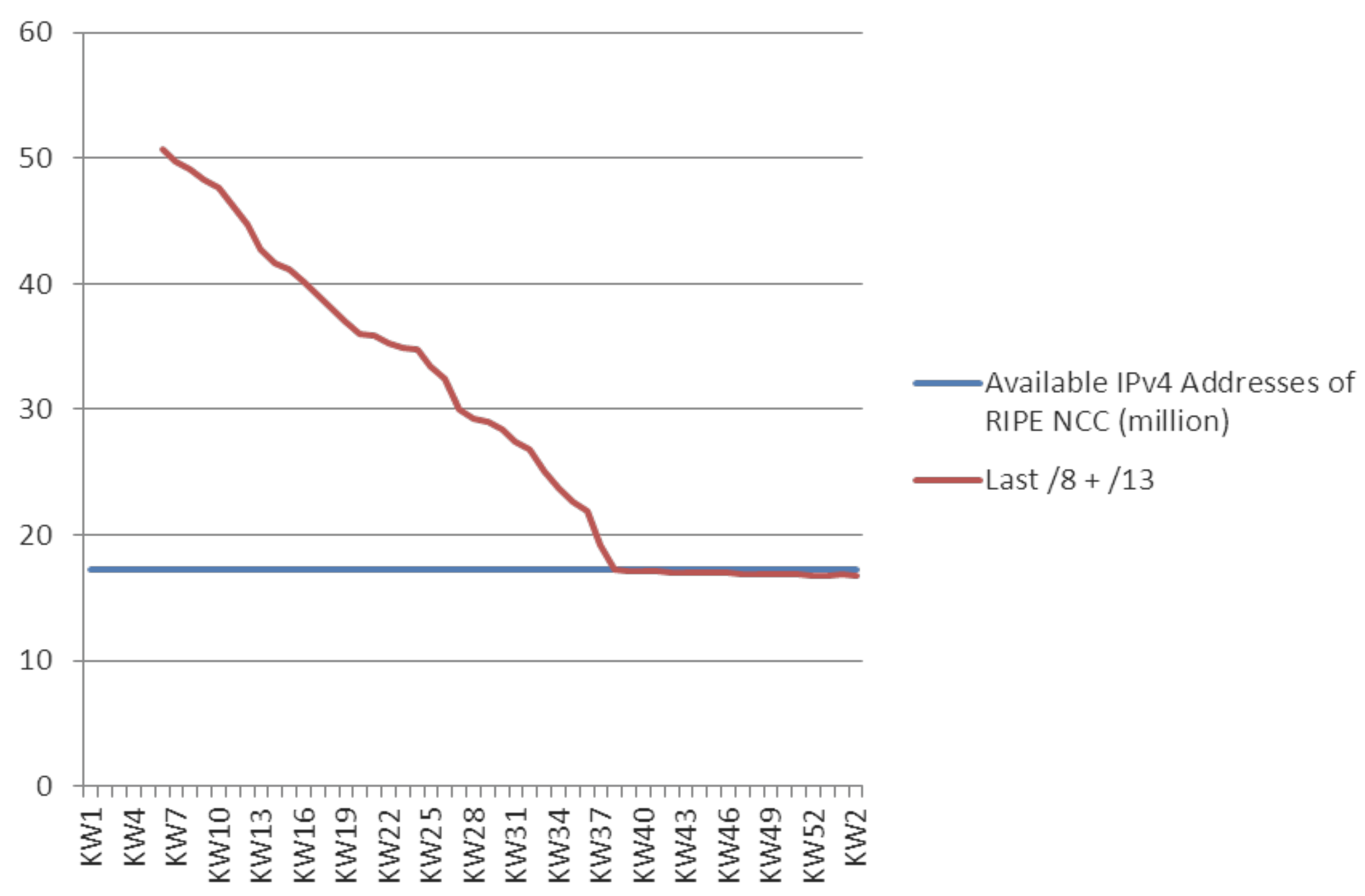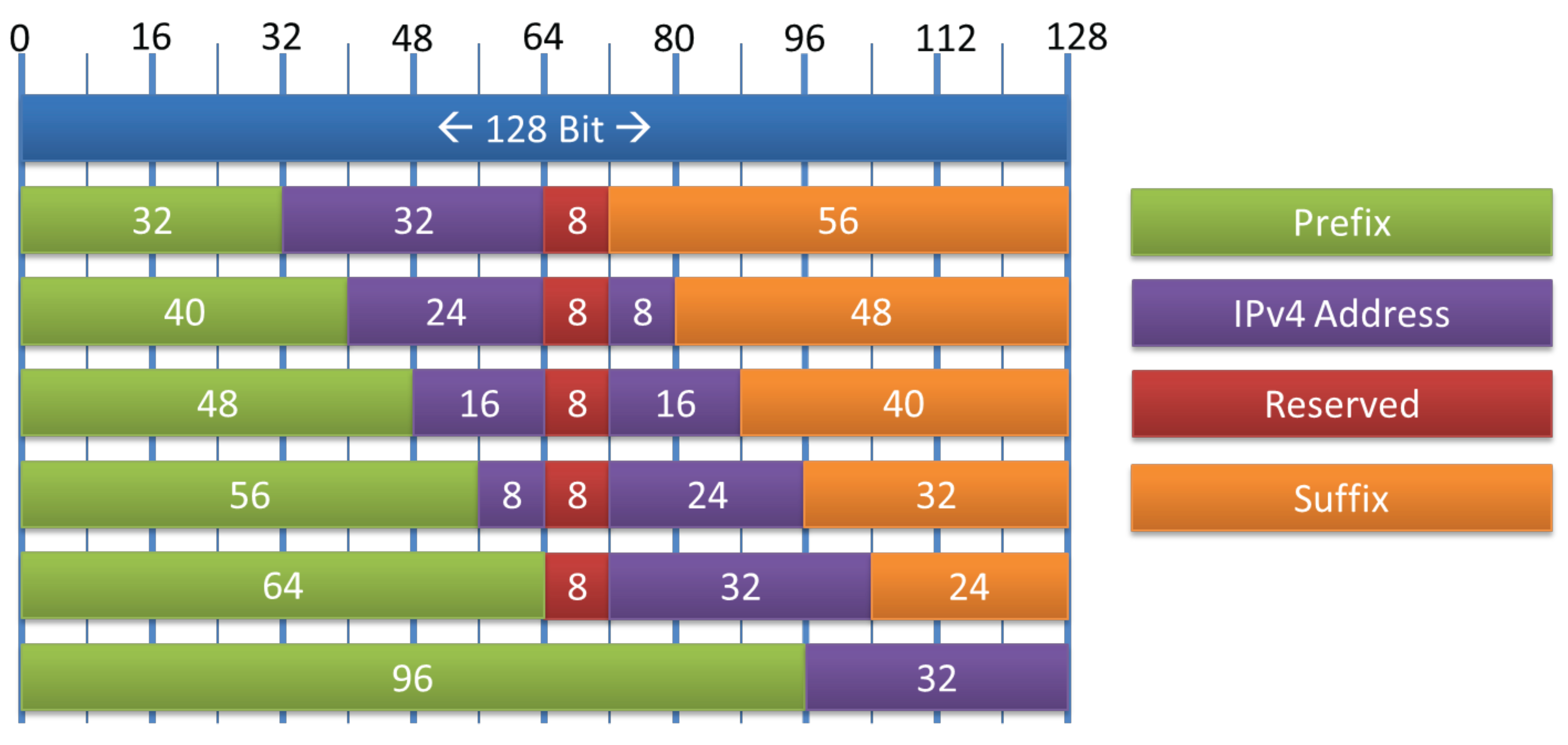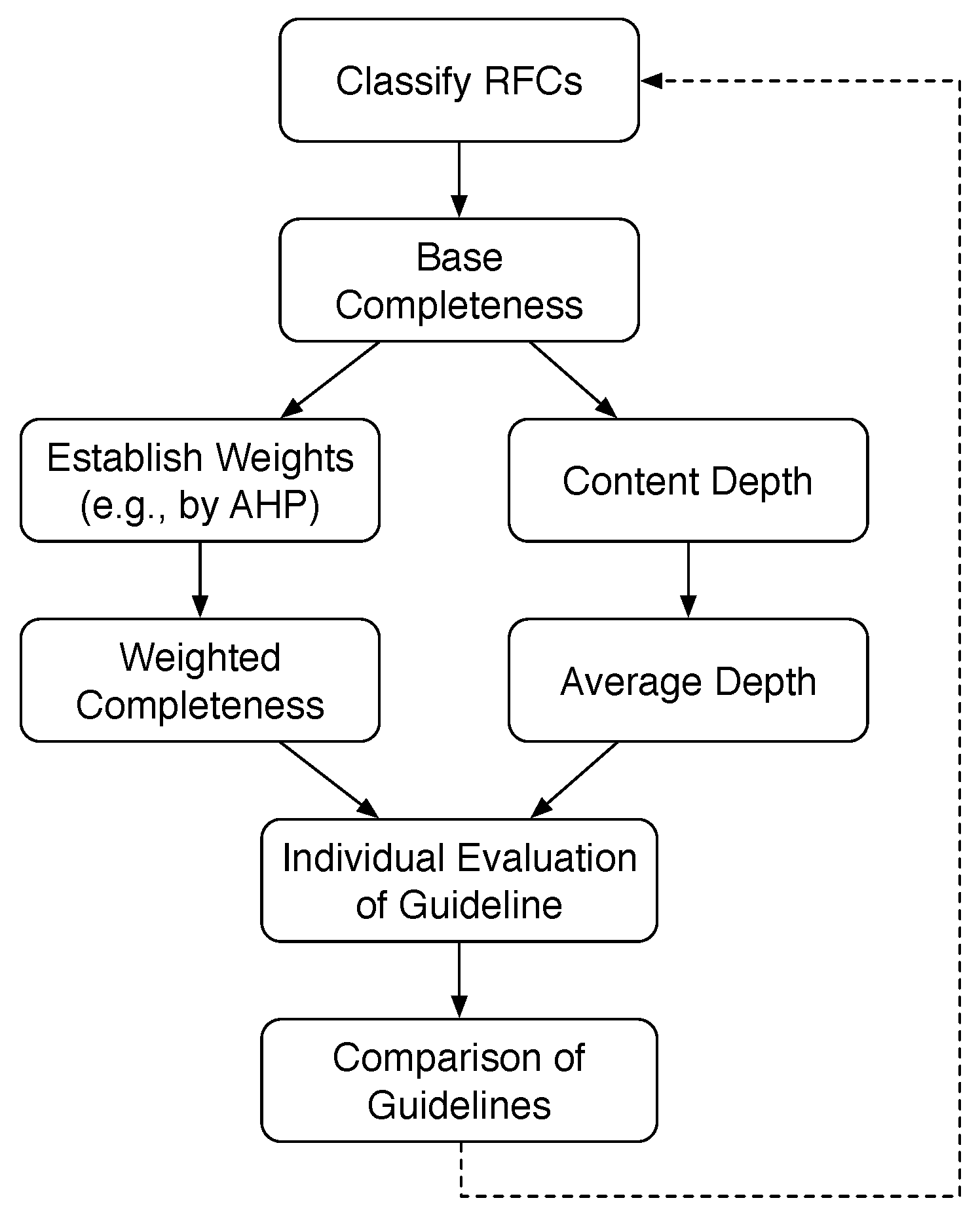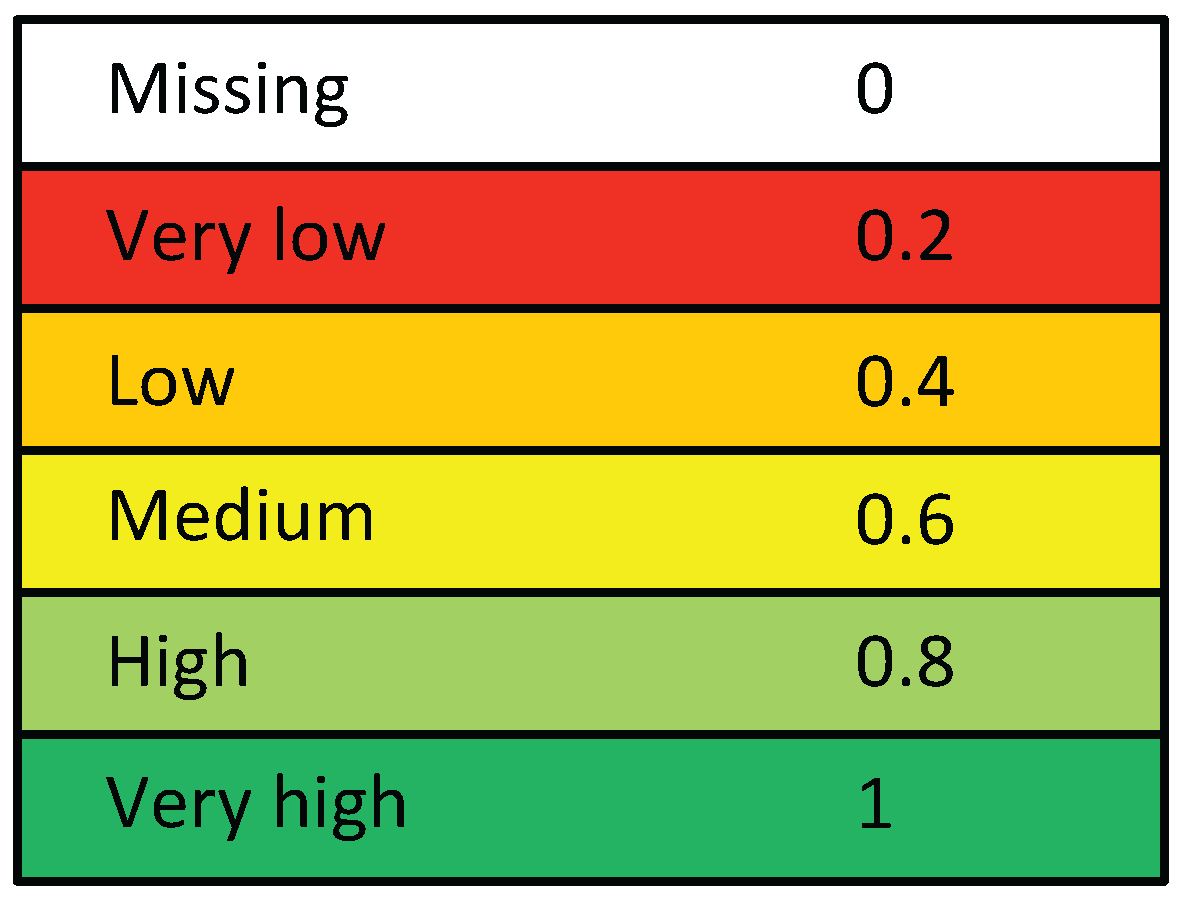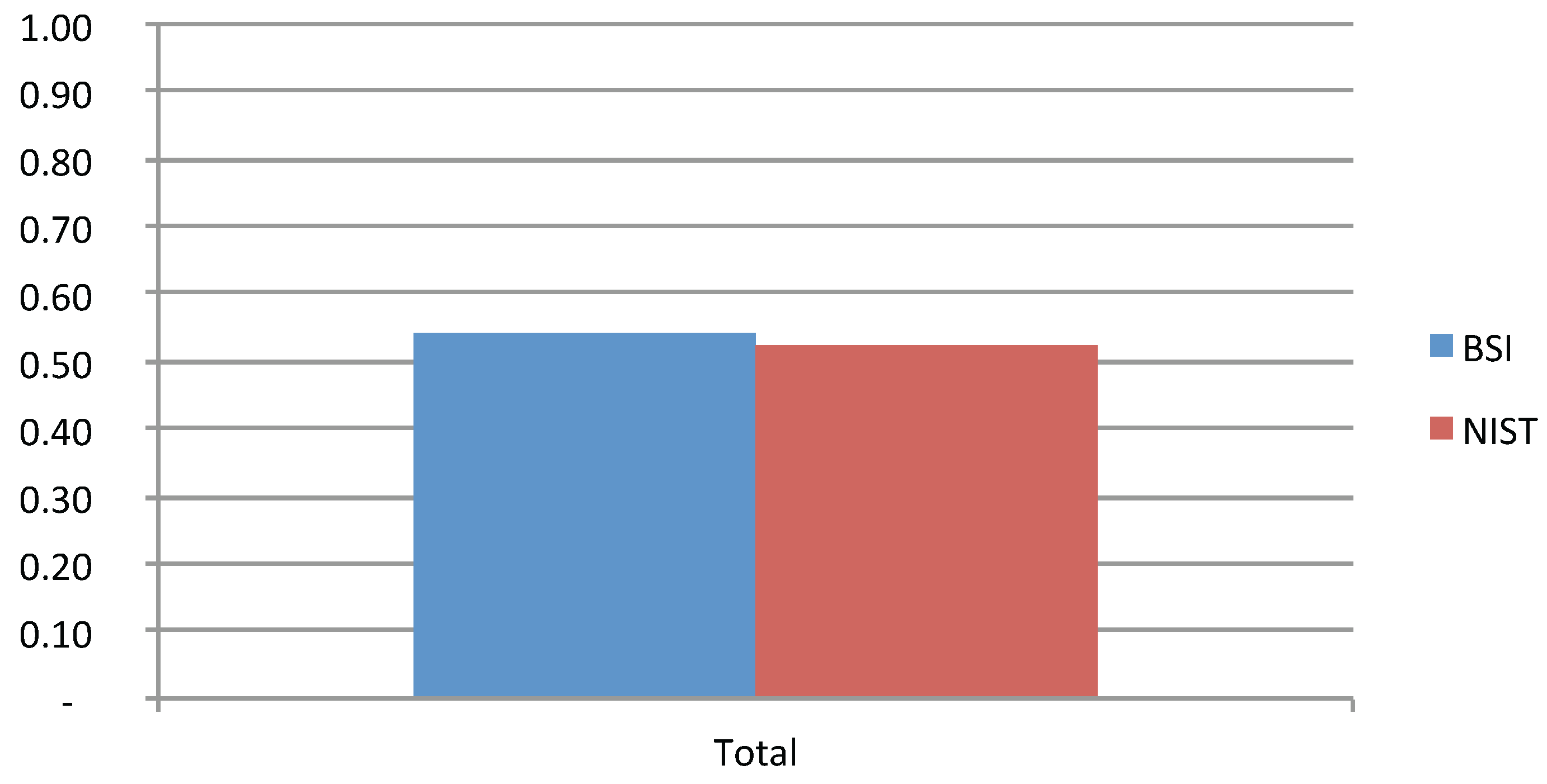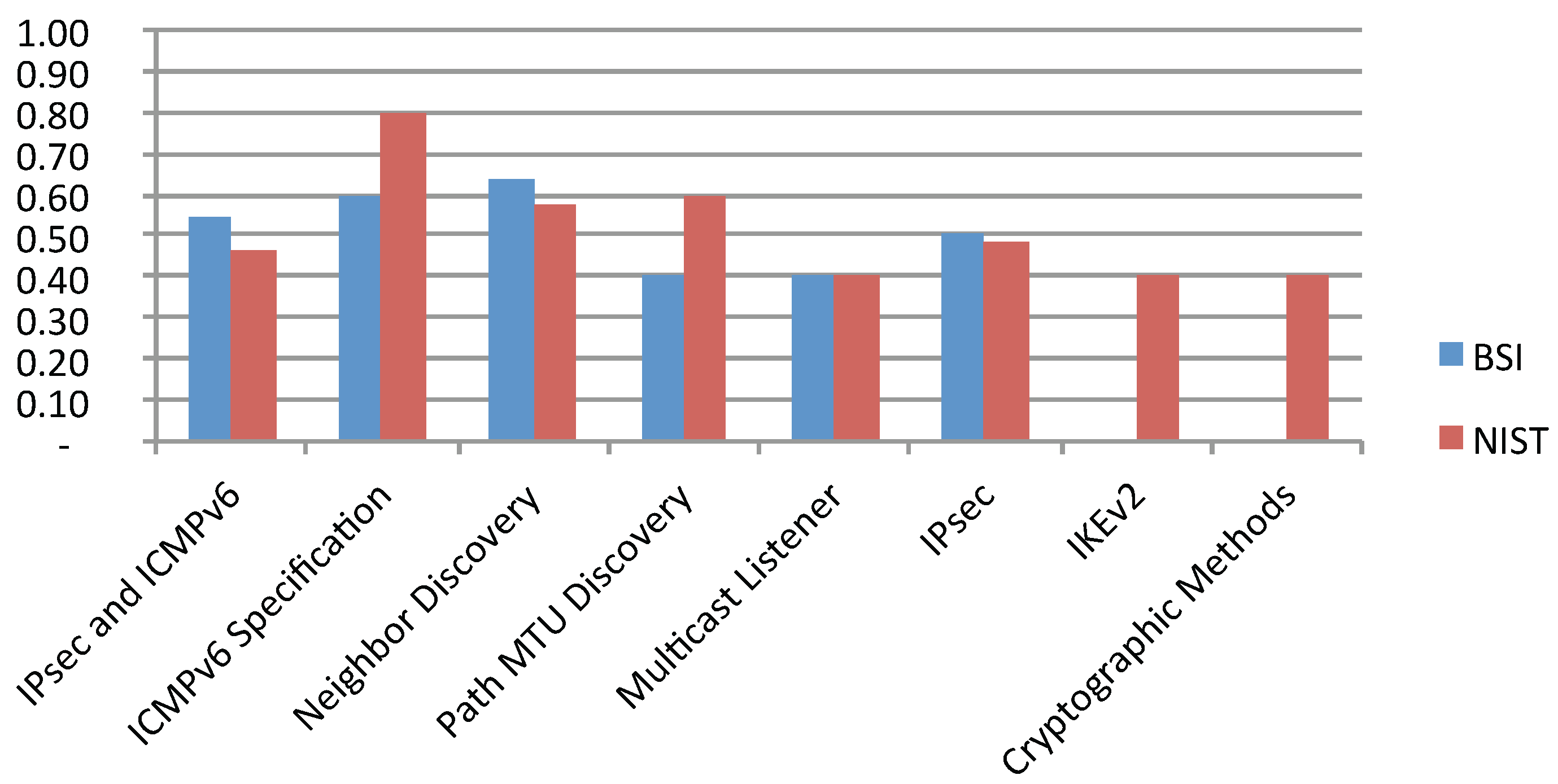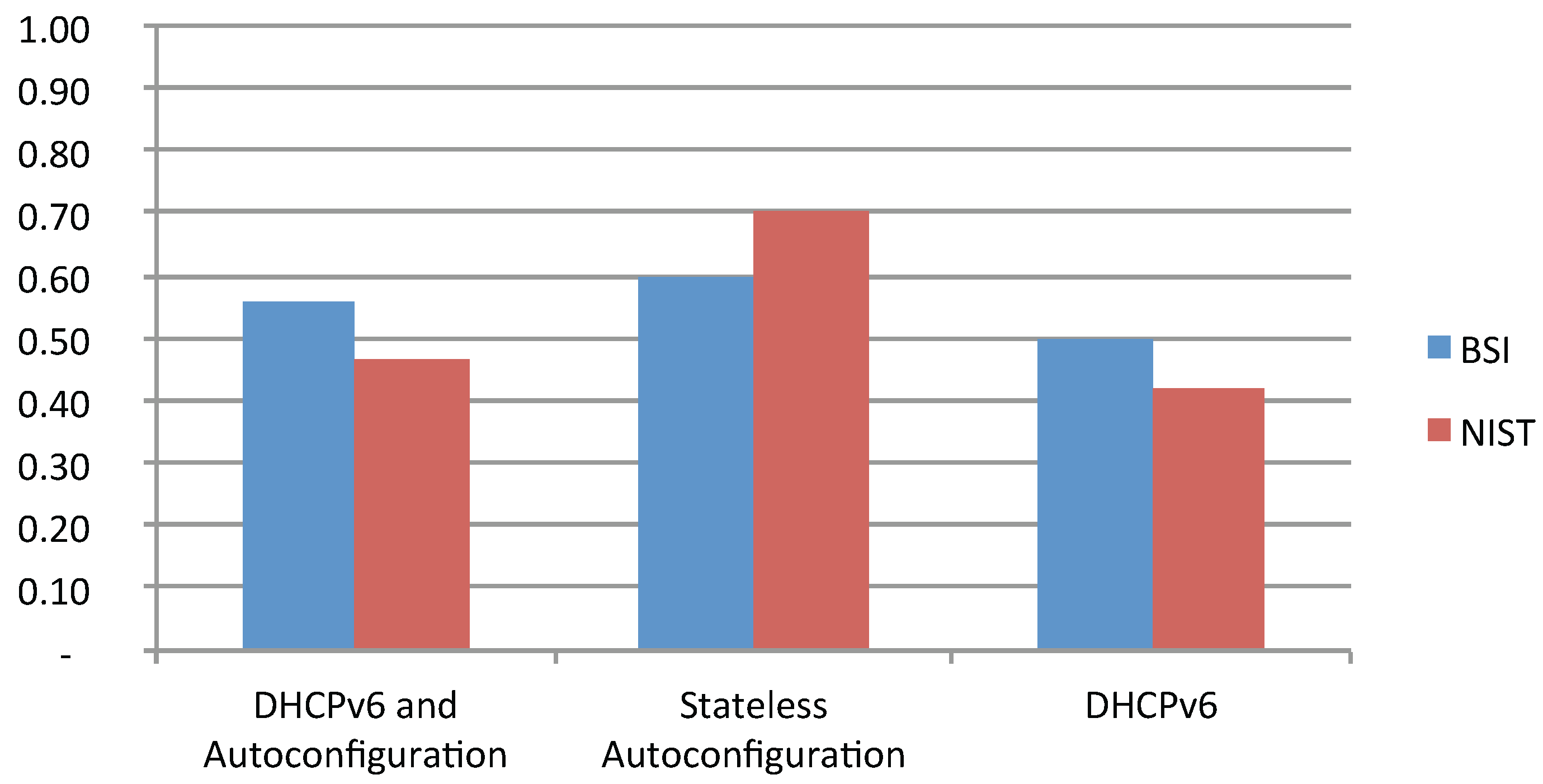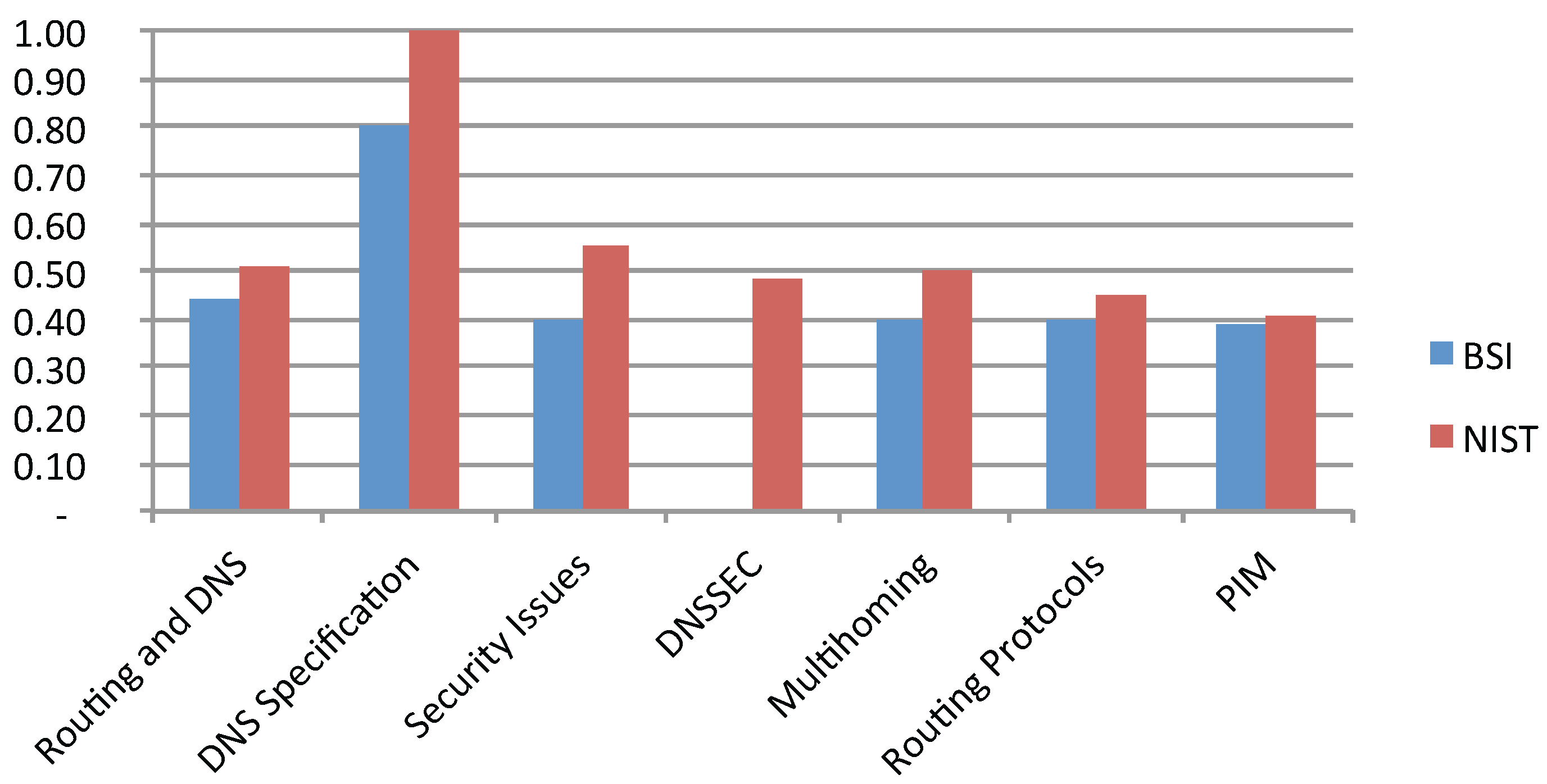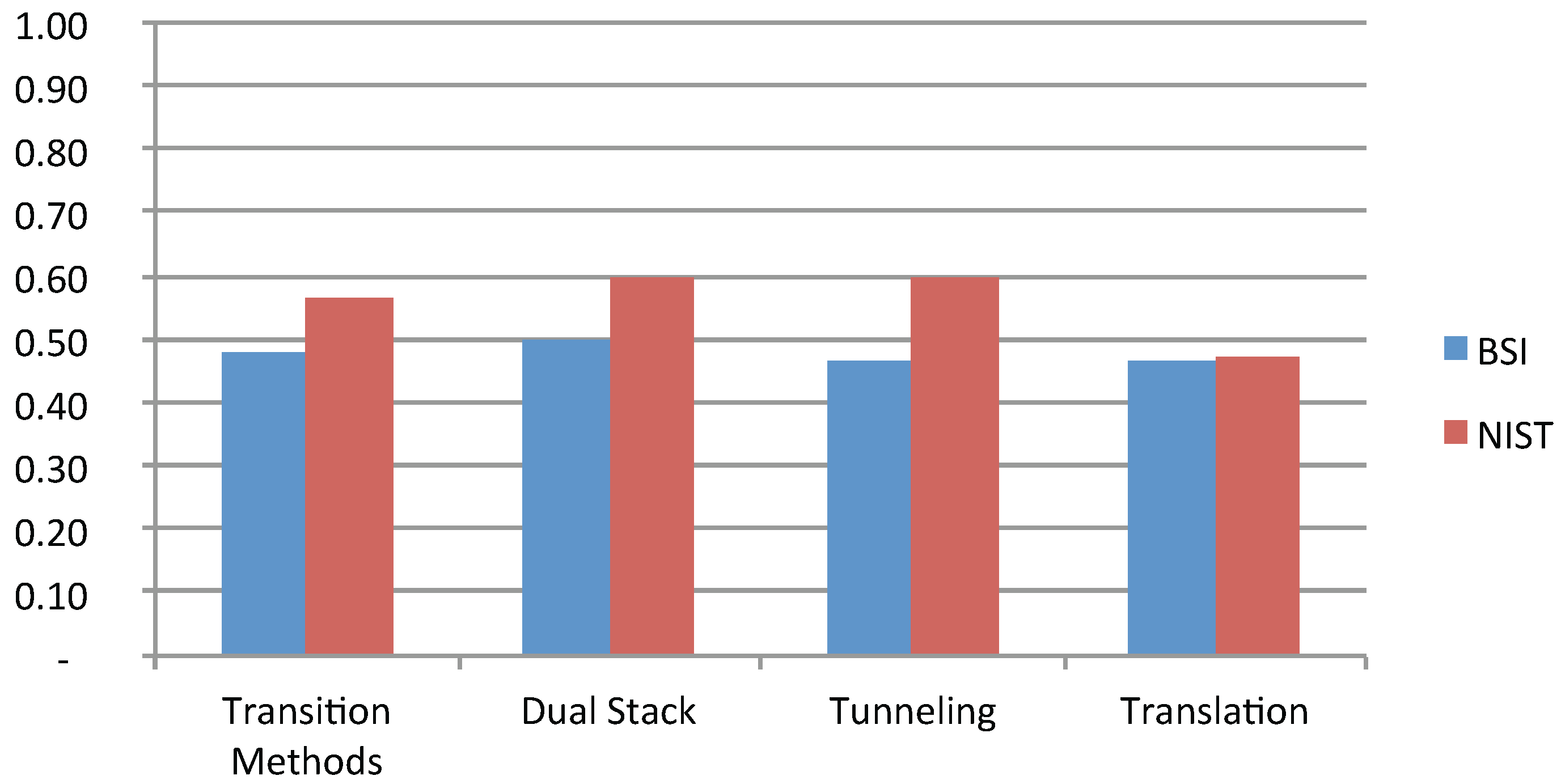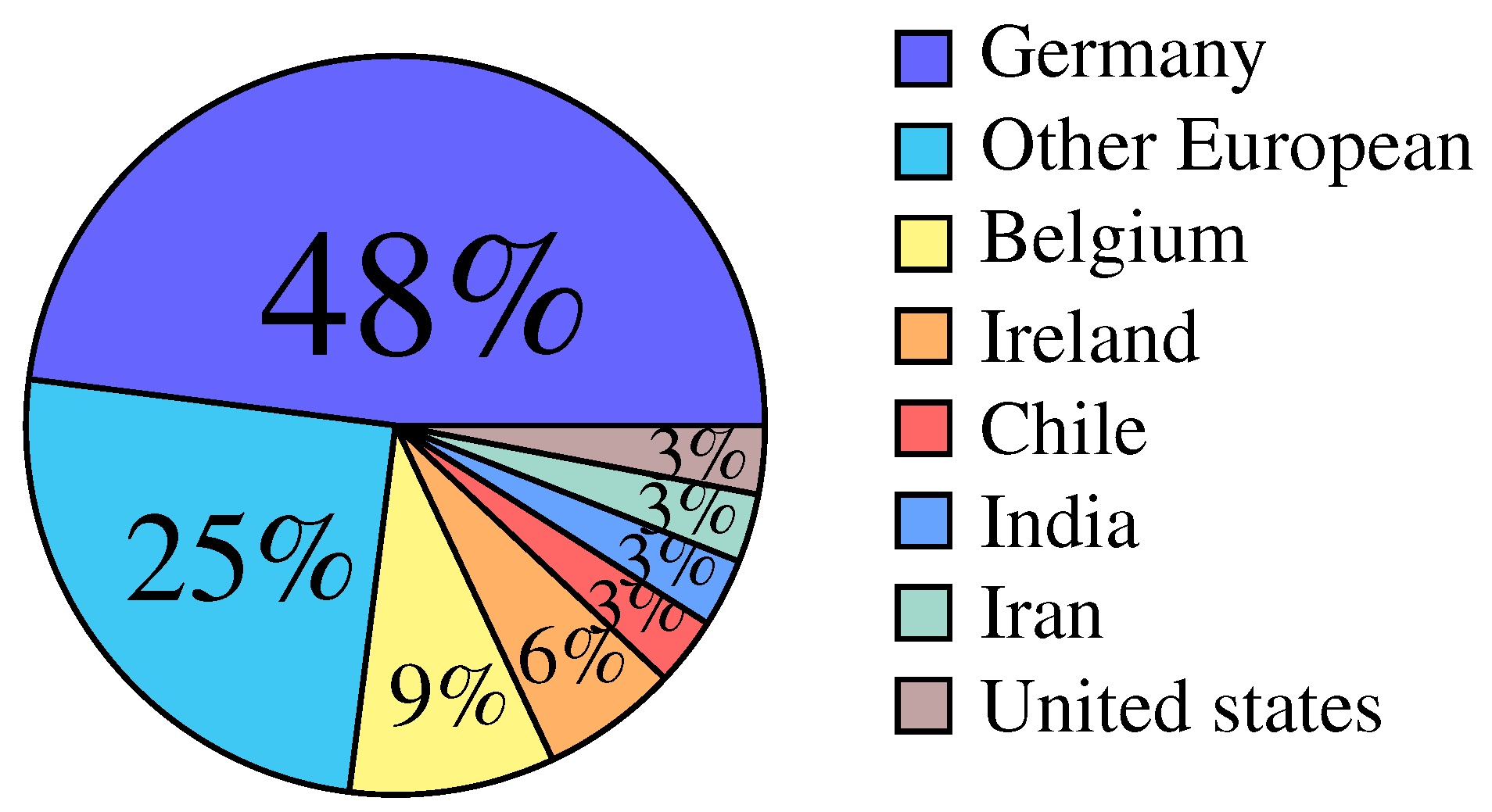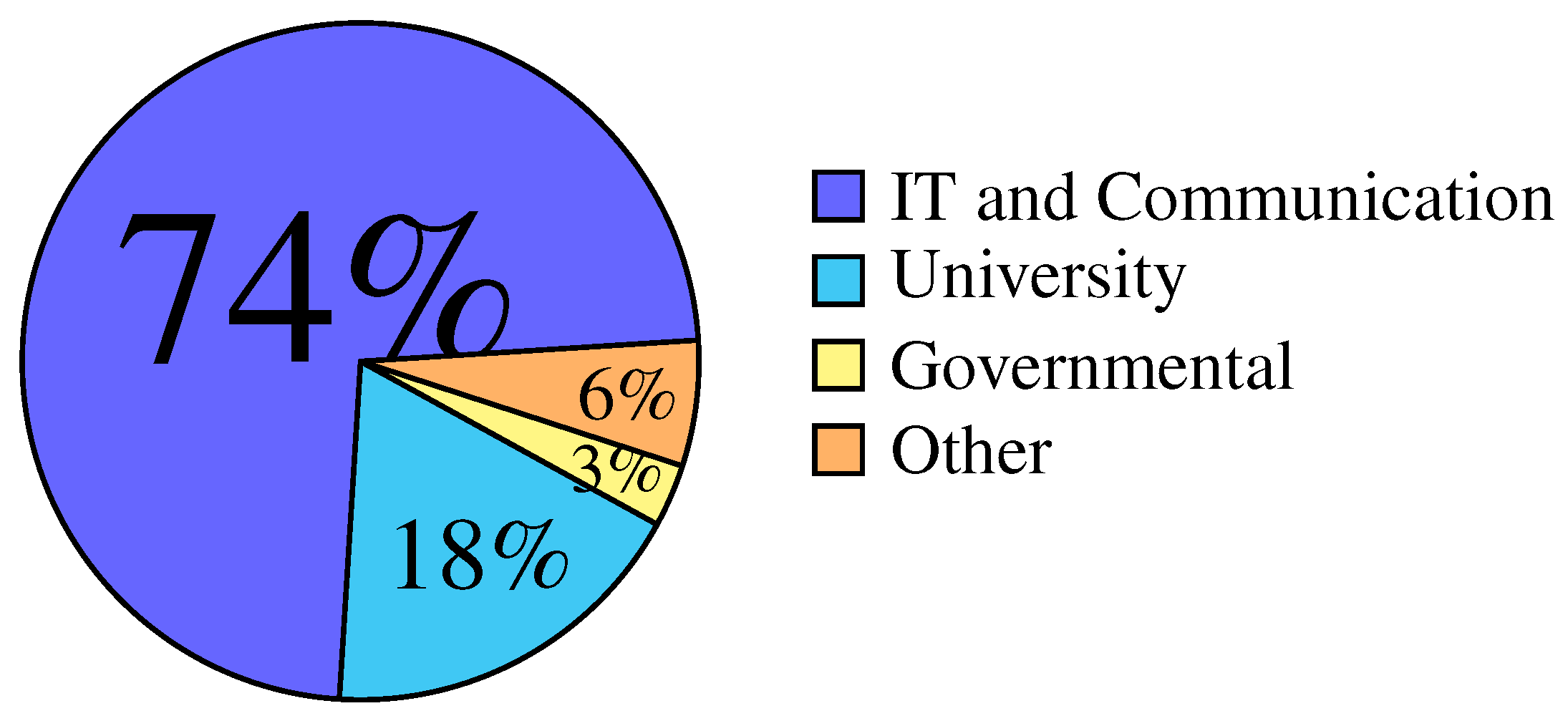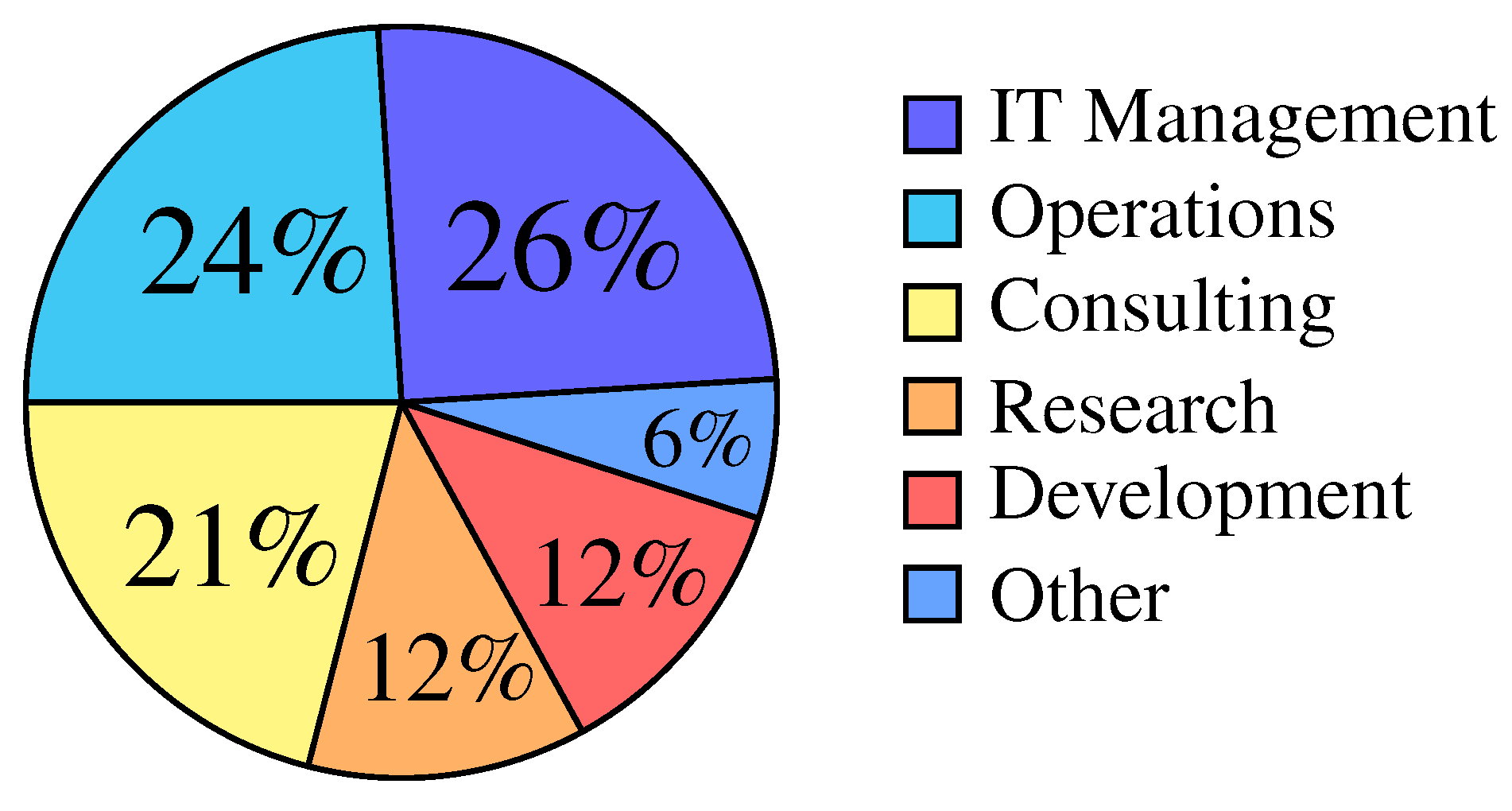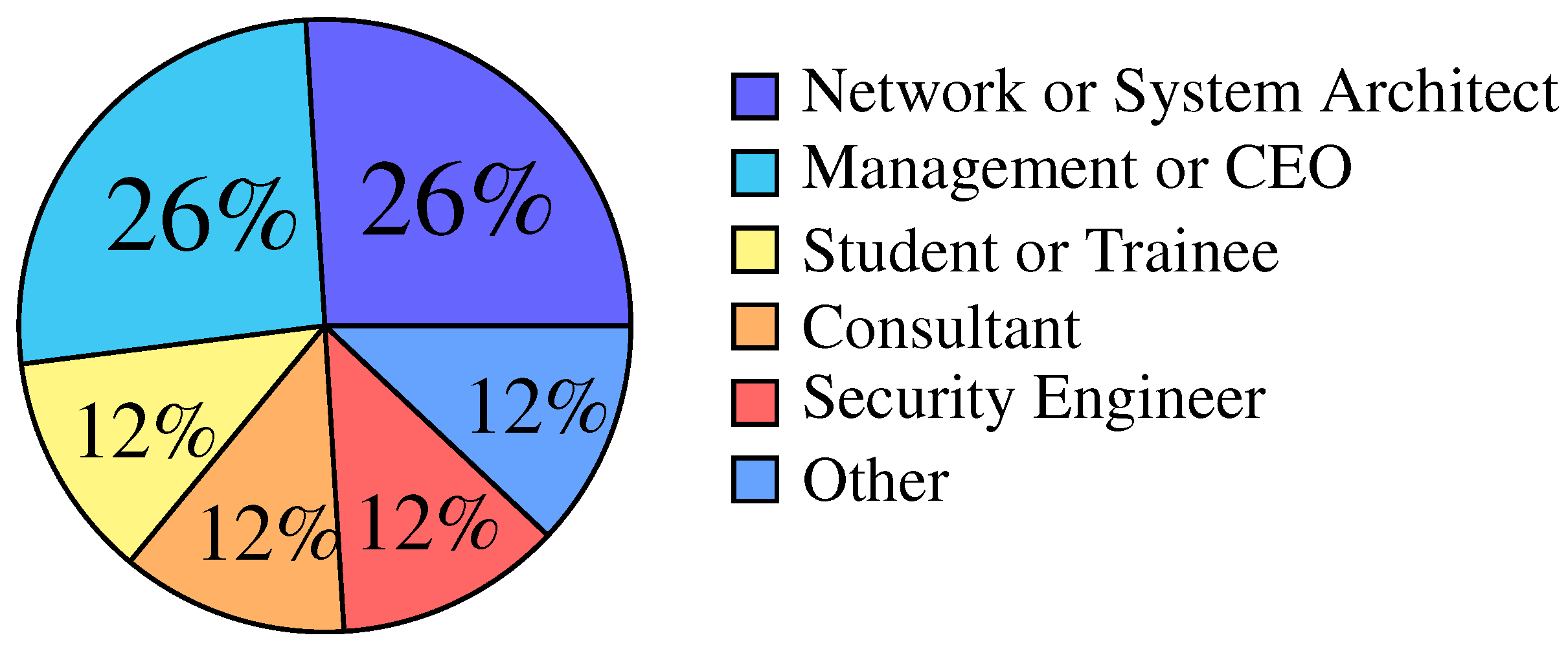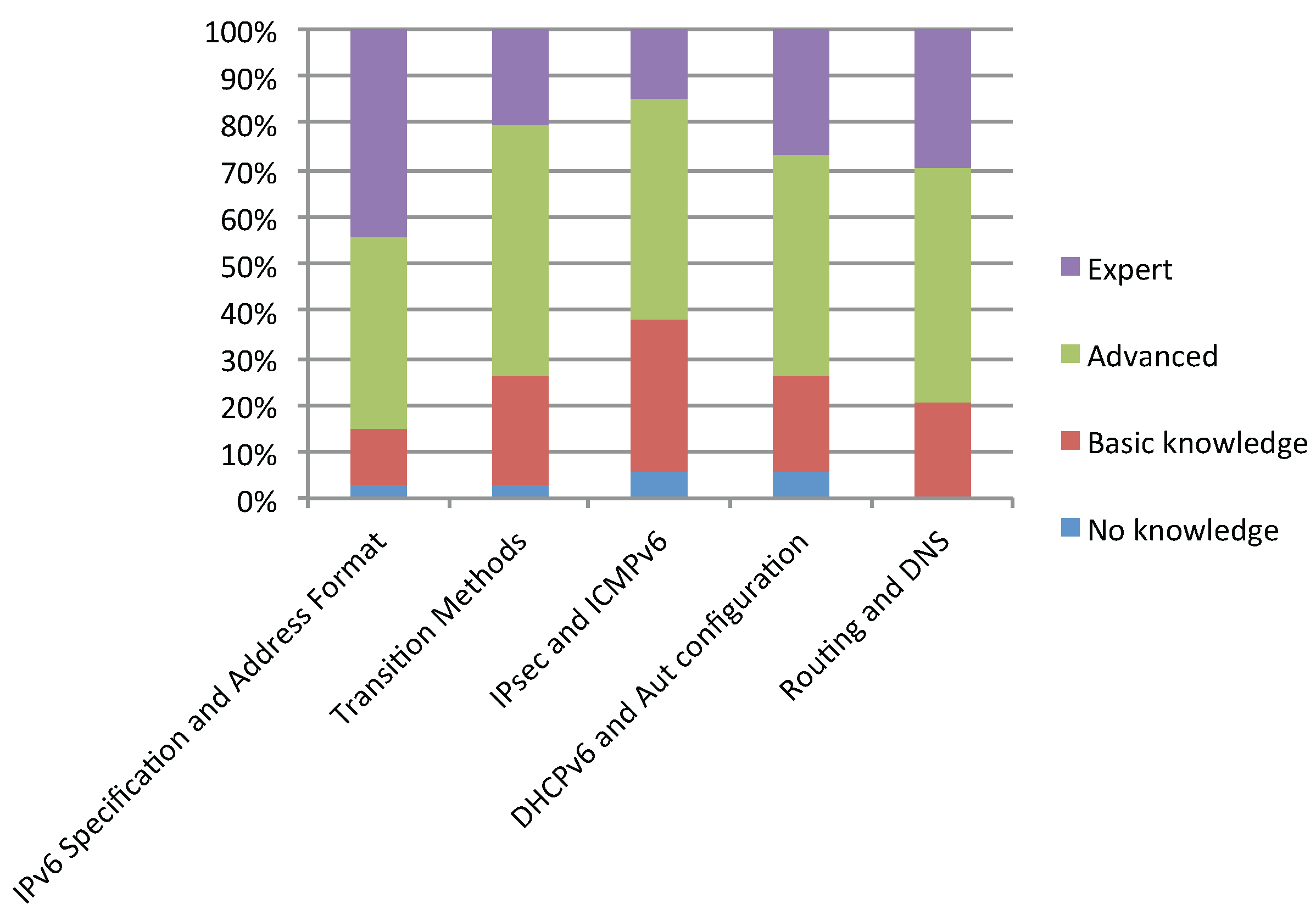2. Introduction to IPv6
IPv6 is the successor of IPv4 and will replace it in the long run as the main protocol of the network layer. IPv6 is aimed at providing end-to-end communication between network interfaces even when the number of Internet participants and corresponding demand for address space keep on increasing massively, for example caused by the growing demand for Internet-enabled mobile devices. Security, Quality of Service (QoS), and reduced load for routers are further goals of IPv6 [
5]. IPv6 is not downward compatible, therefore a simple switch of protocols is not possible. This is also due to various old network devices that are optimized for the use with IPv4 and hence do not support new version. The development of the next generation Internet protocol began in 1993 when people realized that the address space would not suffice forever. IPv6 was first published in 1995 in the RFC 1883 [
1], which was deprecated in 1998 by RFC 2460 [
23].
IPv6 quadruples the address length of IPv4 to 128 bit. This extension leads to an exponentially growth of the address-space size to
undecillion. This would in theory correspond to 6.65 ×
addresses per square meter of the earth. Such a tremendous amount of addresses makes it possible to give a unique address to every device connected to the Internet for a practically indefinite amount of time and enables a true end-to-end communication among them. The effectively available address space is certainly smaller than theoretically possible, since large blocks are reserved for special purposes such as multicast, or for purposes yet unknown. The smallest allocation possible is furthermore a/64 prefix. This leaves 64 bit to be assigned to network devices. While this will also lead to a lot of waste of addresses, this decision was made to improve manageability and routability of networks [
23].
Moreover, there are also further standards published around IPv6 that, for example, define interoperability with other protocols or compatibility with IPv4. Basically, IPv6 serves the same purpose as IPv4 does, namely the packet-oriented connection of host systems. The following are the main features introduced with IPv6: a simplified IP header structure, Extension Headers, Stateless Address Autoconfiguration (RFC 4862) [
24], IP Security Extensions (IPsec), Mobile IPv6 (MIPv6), QoS, route aggregation, and Path Maximum Transmission Unit (PMTU) Discovery.
Although IPv6 has already been specified in 1995, IPv4 is still the most popular protocol in networks of all sizes including the Internet as has been shown by several studies. With CAIDA, kc claffy investigated the global IPv6 peering of AS’s in 2010. Only 307 thousand paths to networks were sufficient to cover 99% of all routed prefixes for IPv6, while 170 million paths where used for IPv4, covering 96% of all routed IPv4 prefixes [
25]. According to Dell Inc., there were only 44 ISPs worldwide who offered native IPv6 connectivity in 2010 [
26].
Why does it take so long for IPv6 to replace IPv4? It is true that the IPv4 address space is very small and would have been exhausted for a long time if the principle of end-to-end connectivity had been upheld. However, techniques such as Network Address Translation (NAT) were developed that are virtually extending the address space, making it possible to use a single address for multiple sites by utilizing formerly unused transport layer ports [
27]. Moreover, some of the features introduced with IPv6, such as IPsec [
28] and QoS, were made available for IPv4 as well. Another problem is the unclear business case for IPv6 [
29]. So far, there are only very few applications leveraging the features of IPv6, and there is barely any noticeable advantage for end customers. Hence, it is difficult for ISPs to sell IPv6 as a feature to customers and charge for it. Until now, most ISPs have postponed the migration of IPv6 to the point of time when it will be indispensable because IPv4 addresses will not be available anymore.
As Regional Internet Registries (RIRs) such as the Réseaux IP Européens Network Coordination Centre (RIPE NCC) hand out the last available addresses, new policies are applied for their allocation. In particular provider-independent PI addresses, which are needed for organizations that require multihoming or prefer their network to be independent from their ISP, are harder to acquire [
30]. There are also some initiatives taking place that encourage testing and implementing IPv6. In 2011, the “IPv6 Day” aimed for an initial large-scale test of IPv6, followed by the “IPv6 Launch” one year later. In 2012, websites like Google, Facebook or Yahoo! did not only test IPv6, but made their websites permanently available via IPv6. More than 70% of the participants are still reachable via IPv6 as of October 2012 [
31]. According to surveys among ISPs and other network related organizations conducted by the Number Resource Organization (NRO), more than 70% of the participants have some kind of IPv6 presence internally or on the Internet. Only 7% do not plan to deploy IPv6 yet. Most of the participants report only very low traffic via IPv6 so far [
32]. This shows that most network companies already have some kind of IPv6 in use and are gaining experience in handling it.
Today almost all address blocks of the five RIRs are allocated. The RIPE NCC keeps statistics on the current available address space that is updated on a weekly basis. An excerpt from February 2012 to January 2013 is shown in
Figure 1. The flat (blue) line represents the last/8 block of IPv4 addresses allocatable by RIPE NCC and a/13 block reserved for unforeseeable events. The red line shows the amount of IPv4 addresses left. As can be seen, the available amount of addresses shrunk very fast until it hit the last/8 block some time around the 38th week of 2012. Since then, new restricted allocation policies have come into force. The maximum allocatable address size from this last/8 block are/22 blocks. Applicants for these address blocks must already have been given an allocation of IPv6 address space. Furthermore, applicants have to prove the need for more IPv4 addresses [
33]. As the graph shows, these policies slowed down the depletion to a great extent. Now, the amount of available IPv4 addresses declines very slowly. In the foreseeable future this pool will subside. While some IPv4 addresses will always be available, larger address blocks will only be allocated from the IPv6 pool. Large companies who received very large address blocks at the beginning of the Internet will have enough space to support their networks for a long time, but new companies who never had the chance to get an IPv4 allocation will have to use IPv6 to build up their network.
Figure 1.
Depletion of Internet Protocol (IPv4) from February 2012 to January 2013.
Figure 1.
Depletion of Internet Protocol (IPv4) from February 2012 to January 2013.
In the following, we will give a brief overview on selected aspects of IPv6 that are important topics for the secure deployment guidelines.
2.1. ICMPv6
The Internet Control Message Protocol Version 6 (ICMPv6) is an important element of IPv6, and at least parts of ICMPv6 have to be used in every network based on IPv6. Similar to the ICMP of IPv4, it handles error messages and can help with network diagnoses through echo requests (ping) and other familiar features. The protocol itself is documented in RFC 4443 [
34]. ICMPv6 is the foundation of some new protocols specially designed for the use with IPv6. These protocols are: Neighbor Discovery, Path MTU, Autoconfiguration and Multicast Listener Discovery (MLD).
Neighbor Discovery (ND) is one of the most important new protocols based on ICMPv6 and serves many functions. It enables each node to find all other reachable nodes within its link and to learn their MAC and link addresses, which replaces the Address Resolution Protocol (ARP). Together with Stateless Address Autoconfiguration it enables devices to receive a network prefix and other configuration information from a router in order to automatically configure the IPv6 address; moreover, a Duplicate Address Detection (DAD) can be performed to ensure uniqueness within the link (or within the scope of the prefix if the link was given its own subnet). Other uses are to check which neighbors are still available and detect changes of link-layer addresses. ND is specified by the IETF in RFC 4861 [
35].
As mentioned above, IPv6 does not only feature
stateful autoconfiguration via DHCPv6 (Dynamic Host Configuration Protocol), but also
stateless autoconfiguration using ICMPv6 messages and DAD, specified in RFC 4862 [
24]. When an interface becomes enabled, it automatically defines its link-local address by combining the fixed link-local prefix
fe80::0 with a unique interface identifier, which could be an Extended Unique Identifier (EUI-64) address as in RFC 4291[
36]. If the router of the link announces a global unicast prefix, nodes can also configure a global unicast address which is routable on the Internet [
24].
Path MTU (PMTU) describes the biggest possible packet size that can be sent via a particular path through a network. The smallest MTU of IPv6 is 1280 byte. This enables the link layer to perform an encapsulation without exceeding the 1500 byte limit of Ethernet. A recommendation is to implement PMTU discovery on every node. The reason for this is that with IPv6 only the source and destination are able to fragment and defragment the packet (exceptions apply if tunneling is used). Every time a packet reaches a node which cannot handle its size, the packet does not get fragmented further; instead an ICMPv6 message “Packet to big” is triggered and sent back to the source. By using PMTU discovery on every node, the PMTU can be established in advance and thus prevent unnecessary traffic. Fragmentation can furthermore be avoided to a large extent by only sending packets of the size of the PMTU if possible. A complete specification of the PMTU discovery can be found in RFC 1981 [
37].
2.2. DNS
The Domain Name System (DNS) has not changed much for IPv6. In general, it works similar for IPv6 as it does for IPv4. It is possible to query for both IPv4 and IPv6 addresses disregarding the type of the network. The resource record for IPv6 is called AAAA record (Quad A). Each AAAA record can only store one IPv6 address so that some hosts could have multiple AAAA records. In an answer all of these addresses would have to be included. For reverse lookup, a new domain ip6.arpa was defined.
Some older applications might have problems handling 128 bit addresses when expecting a 32 bit address. Since multiple addresses could be returned, services must be able to handle this. Another issue could arise if fragmentation of the answer is needed, since fragmentation of IPv6 might not be allowed in some networks. Other security implications are basically the same as with IPv4. There are no new IPv6 specific protection mechanisms because Transaction Signatures TSIG [
38] and DNS Security Extensions DNSSEC [
39,
40,
41,
42,
43] are also applied in the context of IPv4 [
3].
2.3. Transition Methods
Transition methods support gradually moving from IPv4 to IPv6 without major interruptions of services and networks. It is expected that most networks will have to support both IPv4 and IPv6 in parallel for a long time because of legacy equipment and the dependency on others to completely switch to the new protocol. Transition methods can be categorized into tunneling and translation methods.
Figure 2 shows a hierarchical representation of the transition methods.
Figure 2.
Transition methods.
Figure 2.
Transition methods.
2.3.1. Coexistence of IPv4 and IPv6
Dual stacking is probably the easiest way to establish a transition without too many outages. In some cases, however, this might not be possible. Incompatible hardware may be too expensive to replace, so some parts of the network have to stay with IPv4 (at least for a while). Furthermore, dual stacking adds complexity and increases administration workload. This situation leads to a need for further transition or translation mechanics.
6to4 and Teredo—described in
Section 2.3.3.—are mechanics used for tunneling. IPv4-compatible addresses are deprecated because none of the specified transition methods use it anymore. The use of IPv4-mapped IPv6 addresses is discussed in RFC 4038 [
44]. The address structure is
::FFFF/96 + IPv4 address (e.g.,
::FFFF:123.45.67.89). Basically, mapped addresses are used in dual stack networks that are still in transition where a IPv4 only node would like to access an IPv6-only application. However, the use of IPv4-mapped addresses is disabled by default in many systems because of security concerns.
Possibilities to translate IPv4 to IPv6 were enhanced in RFC 6052. The structure is shown in
Figure 3. While formerly/96 prefixes were used like ::/96 or ::FFFF/96, the new standard allows network specific prefixes in various lengths. The length depends on the allocated network prefix. If a unique/96 prefix is used, the IPv4 address does not have to be globally unique. The resulting IPv6 address must be unique if it is supposed to be a global unicast address. If the network does not have its own network prefix, a special prefix can be used. This prefix is called Well-Known prefix and has the form
64:ff9b:/96.
Figure 3.
IPv4 embedded IPv6 address formats [
45].
Figure 3.
IPv4 embedded IPv6 address formats [
45].
Figure 3 shows six specified possibilities to create an IPv4-embedded IPv6 address. Depending on the length of the prefix (green) the structure changes. If the prefix is 96 bit long, the IPv4 address (purple) is just added after the prefix to reach a length of 128 bit. If the prefix is shorter than 96 bit, the IPv4 address is interrupted by an octet of zeros (red). This octet is always placed at the positions 64 through 71. The rest of the address is reserved for a suffix (orange) which is not used yet and has to be set to all zeros. This suffix could be used in the future for additional functions, so IPv4-embedded IPv6 addresses might have to be changed. Many address blocks of the IPv6 address space are still to be assigned to a particular purpose. Overall this accounts for 86% of the available address space. This space is reserved for future developments, which is why IPv6 is—and will continue to be—very flexible for a long time.
2.3.2. Dual Stack
Dual IP layer or Dual Stack is defined in RFC 4213 ([
46], p.1) as a “technique for providing complete support for both Internet protocols—IPv4 and IPv6—in hosts and routers.” At least in part, dual stacking will occur in any transition from IPv4 to IPv6. It is further expected that dual-stacked networks will exist for a long time also after IPv4 depletion. A complete dual stack is probably the best way to avoid security issues involved with IPv4-IPv6 interaction. On the other hand, it does increase administration workload by adding complexity and literally doubling the configuration overhead. Most other transition techniques of the categories tunneling and translation require some kind of dual stacking.
2.3.3. Tunnel
Tunnels for IPv6 were primarily developed to be able to cross IPv4-only sections of a network during transition. Several tunneling techniques have been specified in the last years. This section gives an overview of the currently most prominent tunneling techniques. Since tunnels add complexity and transparency to the network, they are considered temporary tools for IPv6 deployment. If possible, tunnels should be avoided and disabled as soon as they are not needed anymore [
3,
47]. Generally, there are two types of tunnels: Tunnels which have to be manually configured and automatic tunnels. From a security point of view, automatic tunneling is questionable and should always be turned off if it is not used [
47].
Configured tunnels have to be set up and managed manually by an administrator and are specified in RFC 4213 [
46]. For tunneling IPv6 through an IPv4 network the protocol 41 is used and has to be enabled on the route. In case that IPv4 packets are tunneled through an IPv6 network, Generic Routing Encapsulation GRE or Multiprotocol Label Switching MPLS can be used. Configured tunnels do not scale as well as automatic tunnels because administrators have to set up and shut down tunnels manually every time when changes are necessary.
All the following tunnels are automatic tunnels. 6to4 is specified in RFC 3056 [
48]. This technique is used for global reachability and tunneling through the IPv4 Internet. Since the publicly available prefix 2002::/16 is used, a globally unique IPv4 prefix is needed. Networks that want to connect to each other need to have access to the same IPv4 network and set up a 6to4 relay router at the border of both sites. 6to4 is in use in productive systems. The technique, however, has some security implications and should only be used if the ISP does not provide IPv6 prefixes. Among the security threats are source spoofing and Denial of Service (DoS) attacks.
6over4 is specified in RFC 2529 [
49]. It depends on IPv4 multicast as virtual link layer and thus is intended for use within a site rather than for connecting an IPv6 node with the rest of the Internet. IPv4 multicast must be enabled in the entire network. IPv6 interfaces are assigned a unicast address with a valid 64 bit prefix and a 32 bit IPv4 address as suffix. Additionally, they are assigned a link-local address. So far, this method is not widely used. 6rd (IPv6 rapid deployment) is similar to 6to4 but does not use the publicly available prefix. It requires a globally routable IPv6 prefix. This technique is specified in RFC 5969 [
50]. It is primarily meant for use by ISPs as a fast deployment of IPv6 to their customers. The IPv6 address is constructed by the network prefix in concatenation with a prefix-reduced customer IPv4 address. The calculation of the prefix is automated and conform with automatic reset of IPv4 addresses because it recalculates the prefix every time.
Teredo was developed by Microsoft and later approved by the IETF in RFC 4380 [
51]. It is meant to solve the problem of tunneling IPv6 through NATs or multiple layers of NATs by using the User Datagram Protocol (UDP) instead of IP protocol 41. It can be used as “technology of last resort” [
3] for deployment of IPv6 hosts behind NAT. Teredo provides automatic tunneling and uses addresses of the following type:
2001:0000::/32 + Teredo Server IPv4 address (globally unique) + Flags + Port + Client IPv4 address. However, Teredo has many security issues. It requires UDP port 3544 to be open, and rogue Teredo servers could be used for man-in-the-middle attacks. DoS and distributed DoS could also be issues [
51].
Intra-Site Automatic Tunnel Addressing Protocol (ISATAP) is used for connecting isolated IPv6 hosts within a site network. ISATAP is specified in RFC 5214 [
52]. This technique is meant for an early stage IPv6 transition, when small IPv6 islands exist. It is supported by almost all operating systems which feature IPv6. Hosts using ISATAP must be dual stacked while the connecting network can be entirely IPv4, with each ISATAP host connected to at least one ISATAP router. The use of ISATAP is recommended to be stopped as soon as IPv6 connectivity is established in the network. Operating systems, which have automatic tunneling enabled by default, should be configured to have it turned off if ISATAP is not needed.
Tunnel brokers deploy dual stack tunnel servers with access to the Internet. Clients can connect to tunnel brokers that establish a tunnel in return. The tunnel broker is responsible for the complete management including DNS, authentication, and access control. The main use of tunnel brokers is for experimental reasons or single individuals not having native support by their ISP yet. Configurations vary depending on the tunnel broker. Information about tunnel brokers can be found in RFC 3053 [
53]. There are two more “tunnel techniques” still in development. One is Dual Stack Transition Mechanism (DSTM) that is a transition mechanic using 6over4 for IPv6 dominant networks [
54]. The second is the Bi-Directional Mapping System (BDMS) which tries to avoid tunneling but focuses on translation mechanisms [
55]. Both have not made it to a standard track by now and are considered experimental.
2.3.4. Translation
Translation mechanisms try to translate IPv6 packets into IPv4 packets and vise versa. This can be done on different layers as shown in
Figure 2. Translation techniques are discouraged as transition approach because they can impede hierarchical routing and do not take advantage of the new header and extended address space [
3]. The most important techniques are explained in the following.
Stateless IP/ICMP Translation (SIIT) is used on the network layer and defined in RFC 6145 [
56]. It makes use of IPv4-converted and IPv4-translatable addresses, which are a subset of IPv4-embedded addresses explained in
Section 2.3.1. While still called stateless, this technique offers a stateless and a stateful mode, compliant with the rules defined in RFC 6052 [
45]. SIIT can handle ICMP as well as IP packets in both directions. For ICMP only the vital messages such as echo are translated, most others are dropped. Generally, only information that is 1:1 translatable is in fact translated. Other information, such as option fields, are ignored or can cause the packets to be silently dropped. While not introducing new security issues, SIIT is not able—and not supposed—to translate all traffic. Network Address Translation-Protocol Translation (NAT-PT) is the combination of SIIT (old specification) and IPv4 NAT. It is specified in RFC 2766 [
57] and is still valid but moved to historic status by RFC 4966 [
58]. NAT-PT should not be used because it is vulnerable for DOS attacks, does not support DNSSEC, and IPsec cannot be translated. Furthermore, it hinders the complete deployment of IPv6 and IPv6 applications. NAT-PT is replaced by SIIT as in RFC 6145.
Transport Relay Translation (TRT) aims to solve the translation problem on the transport layer and defines a method for Transmission Control Protocol (TCP) and UDP traffic. TRT is a stateful translation technique and uses DNS mapping between AAAA and A records and is defined in RFC 3142 [
59]. It is vulnerable to DoS attacks and does not support IPsec. ALT techniques were developed to handle legacy applications that use IPv4 but cannot be upgraded to IPv6 or be replaced. Most of them present an artificial pool of IPv4 addresses to the application and then translate requests [
3].
4. NIST Guidelines for the Secure Deployment of IPv6
The National Institute of Standards and Technology (NIST) was founded in 1901 and is now part of the U.S. Department of Commerce. Its mission is to promote U.S. innovation and industrial competitiveness by advancing measurement methods, standards, and technology in ways that enhance economic security and improve quality of life. NIST has laboratories for many different areas of science but mostly physical science as chemistry, physics, biology, and others. Among them is the Information Technology Laboratory and one of its divisions, the Computer Security Division [
63]. It provides standards and technology to protect information systems against threats to confidentiality, integrity, and availability of information and services. Thus, the division publishes their own standards and works together with other standardization organizations such as the IETF. Beside standards, NIST and the Computer Security Division also publish security guidelines for different areas, e.g., cryptographic algorithms, and also provide evaluations and best practices for the use of standards [
64].
In 2010 NIST published the “Guidelines for the Secure Deployment of IPv6” [
3]. The document is meant to give a comprehensive overview about IPv6 and point out possible threats regarding the different areas and technologies that are influenced by IPv6. Special focus is given to the security risks that might appear during deployment and transition to IPv6, since this is a critical evolution step for any network. It also provides a suggestion for a deployment strategy with a rough outline of recommended steps for the transition. The full document is 212 pages long and available for free download [
3]. It does not require the reader to know IPv6, but knowledge about IPv4 and other networking protocols is necessary to a certain extent.
The NIST guide is structured in the following way. After a short introduction, the second chapter introduces IPv6, its history, major features, and a comprehensive comparison of threats for IPv4 and IPv6. The third chapter is focused on general IPv6 concepts. These include IPv6 addresses, addressing and allocation as well as the IPv6 header, extension header, ICMPv6, and DNS. The fourth chapter covers advanced IPv6 features in more detail. These include multicast, QoS, Multihoming, DHCPv6, and Mobile IPv6. The fifth chapter continues with security mechanisms such as privacy addresses, cryptographically generated addresses, IPsec in IPv6, and secure stateless address autoconfiguration. The final chapter focuses on the deployment of IPv6 and describes transition mechanisms, secure addressing schemes, and recommends steps and actions for the preparation of a deployment.
4.1. Content Completeness and Depth of the NIST Guide
For the evaluation of content completeness and depth, the NIST guide was checked for coverage of the RFCs listed in
Appendix A. The main categories remain the same as in the survey. Additionally, the weights derived by AHP using the results from the survey from
Section 3.3.1. of the
Appendix were applied to derive the weighted completeness that for each main category multiplies its result by its weight and then adds them all up. For weighted completeness only the end result of the guide counts while (basic) completeness is shown for every subcategory, category and the whole guide.
Depth is calculated as explained in
Section 3.1. This depth score is aggregated for every subcategory, category, and for the overall guide. The following list shows the legend for
Table 6 and explains the columns: A = Count of covered RFCs, B = Count of relevant RFCs, C = Completeness, D = Weight (gray rows)/Importance Rating (white rows), E = Weighted Completeness (A*D), F = Depth. Category rows are shaded gray and show their subcategories below them (white rows). Values for subcategories are aggregated to the main categories. Totals are shown in the last line of the table.
Overall: As the totals of the last line of the table show, the NIST guide covers 174 of the 213 RFCs selected for evaluation. This results in a completeness of 0.82 or 82%. This result does not change much when applying the weights. The weighted completeness is 0.81 or 81%, which is only 0.01 less than completeness without weights. Thus, overall the NIST guide covers many of the existing RFCs regarding IPv6 and seems to be closely aligned to the preferences derived by the opinion of the survey participants. The overall depth is only 0.43 which translates to a little above low when translating it into a depth category.
Table 6.
NIST Content Completeness and Depth. Columns: A = Count of covered RFCs; B = Count of relevant RFCs; C = Completeness; D = Weight/Importance Rating; E = Weighted Completeness (A * D); F = Depth.
Table 6.
NIST Content Completeness and Depth. Columns: A = Count of covered RFCs; B = Count of relevant RFCs; C = Completeness; D = Weight/Importance Rating; E = Weighted Completeness (A * D); F = Depth.
| Category | A | B | C | D | E | F |
|---|
| Specification & Address Format | 50 | 57 | 0.88 | 0.22 | 0.19 | 0.52 |
| Specification | 4 | 4 | 1.00 | 6.17 | | 0.75 |
| Address Features | 18 | 19 | 0.95 | 6.69 | | 0.64 |
| Header | 9 | 13 | 0.69 | 6.05 | | 0.34 |
| Mobile IPv6 | 19 | 21 | 0.90 | 5.76 | | 0.49 |
| IPsec & ICMPv6 | 59 | 69 | 0.86 | 0.14 | 0.12 | 0.40 |
| ICMPv6 Specification | 5 | 6 | 0.83 | 6.03 | | 0.67 |
| Neighbor Discovery | 7 | 11 | 0.64 | 6.59 | | 0.36 |
| Path MTU Discovery | 1 | 1 | 1.00 | 6.00 | | 0.60 |
| Multicast Listener Discovery | 4 | 5 | 0.80 | | | 0.32 |
| IPsec | 10 | 13 | 0.77 | 6.93 | | 0.37 |
| IKEv2 | 13 | 13 | 1.00 | 5.66 | | 0.40 |
| Cryptographic Methods | 19 | 20 | 0.95 | 5.69 | | 0.38 |
| DHCPv6, Autoconfiguration | 12 | 14 | 0.86 | 0.21 | 0.18 | 0.40 |
| Stateless Autoconfiguration | 2 | 2 | 1.00 | 6.66 | | 0.70 |
| DHCPv6 | 10 | 12 | 0.83 | 6.28 | | 0.35 |
| Routing & DNS | 29 | 40 | 0.73 | 0.24 | 0.17 | 0.37 |
| DNS Specification | 1 | 3 | 0.33 | 6.03 | | 0.33 |
| Security Issues | 8 | 9 | 0.89 | 6.62 | | 0.49 |
| DNSSEC | 5 | 9 | 0.56 | 5.69 | | 0.27 |
| Multihoming | 6 | 7 | 0.86 | 5.00 | | 0.43 |
| Routing Protocols | 4 | 5 | 0.80 | 6.03 | | 0.36 |
| PIM | 5 | 7 | 0.71 | 4.62 | | 0.29 |
| Transition Methods | 24 | 33 | 0.73 | 0.20 | 0.15 | 0.41 |
| Dual Stack | 4 | 4 | 1.00 | 7.38 | | 0.60 |
| Tunneling | 12 | 16 | 0.75 | 6.38 | | 0.45 |
| Translation | 8 | 13 | 0.62 | 6.21 | | 0.29 |
| Totals | 174 | 213 | 0.82 | | 0.81 | 0.43 |
Specification and Address Format: The category Specification and Address format has 57 relevant RFCs, of which 50 are covered in the guide by NIST. This leads to a completeness of 0.88 and thus almost 90%. The missing points come from subcategory Header (4), Mobile IPv6 (2) and Address format (1). The completeness of this category is very high and shows that the guide at least mentions many of the relevant RFCs. The depth is at 0.52 which translates to between low and medium with a tendency to medium. When looking into the subcategories, this value results from a low depth of the subcategories Header (0.34) and Mobile IPv6 (0.49) while the other two subcategories achieved higher depth values. From the point of view of the importance ratings, Header and Mobile IPv6 also got lower scores, therefore a less deep coverage must not be automatically considered as negative. In general, the category Specification and Address format is well covered, which also aligns with the importance of its subcategories.
IPsec and ICMPv6: IPsec and ICMPv6 are also well covered by the NIST guide. 59 out of 69 relevant RFCs are mentioned, which results in a completeness of 0.86 or 86%. Except for the subcategories Path MTU Discovery and IKEv2, all other of the seven subcategories miss some points. The lowest scores pertain to Neighbor Discovery (4 missing) and IPsec (3 missing). Again, 0.86 is a very good result and shows that very many of the relevant RFCs are at least mentioned. The depth of this category is at 0.4 (low). Many of the subcategories have a very low depth. Only Path MTU Discovery and ICMPv6 Specification achieved a depth of 0.6 or higher. Other subcategories should have been covered in more detail as they received high importance ratings in the survey. These are in particular Neighbor Discovery and IPsec. Neighbor Discovery has an importance rating of 6.59 but only has a depth of 0.36 and thus is not described sufficiently. IPsec is rated even higher for importance (6.93) and also achieves only a depth of 0.37 (less than low). As one of the most important topics, this clearly shows a deficit and should be considered for improvement. The other subcategory scores for depth are well aligned to the importance rating they achieved. In general, this category is covered to a large extent in the NIST guide, but focus for detailed coverage should be shifted to the more important topics.
DHCP and Autoconfiguration: This smaller category with only 14 relevant RFCs is covered well by the NIST guide. 12 out of 14 RFCs are at least mentioned in the guide. The two missing points are coming from the subcategory DHCPv6. The resulting completeness is 0.86 or 86% and thus a good result. Depth of this category is only 0.4. This results from a very low depth of the subcategory DHCPv6 (0.35) and a high depth of Stateless Autoconfiguration (0.70). The depth of DHCPv6 is too low in relation to its importance rating of 6.28 and should be given more attention. Generally, the coverage of this category is good with room for a few improvements in depth.
Routing and DNS: With a coverage of 29 of 40 possible relevant RFCs and a completeness of 0.73 (73%) Routing and DNS is one of the less covered categories. Nevertheless, 73% is a good result, but could be better considering the highest weight of all five categories. None of the subcategories is completely covered, with DNSSEC missing 4 RFCs and, thus, the most of all. Depth of the category is 0.37. This indicates that the highest weighted category is not described well. Going into detail, this results from an overall low depth within the category. None of the subcategories achieved a depth above 0.5. Especially Security Issues, Routing Protocols and DNS Specification should be described in a more extensive way, as they received relative high importance ratings. The other subcategories were not rated very high for importance and thus do not necessarily need to be covered more. In general, this category should be covered more to increase depth and completeness for a better alignment to its importance.
Transition Methods: 24 out of 33 relevant RFCs are covered in this category in the NIST guide. Thus the completeness is 0.73 or 73%. Regarding the weighting of the category, this is a good result. Points are missing in the subcategories Tunneling (4) and Translation (5) while Dual Stack is completely covered. The depth of Transition Methods is at 0.41 translating into a little above low. Looking at the subcategories, the depth of Translation is too low relative to its importance rating of 6.21. The same holds for Tunneling: even though its depth is 0.45 it could be higher. This is partially due to newer versions of RFCs, which are not yet included in the guide. Last but not least, Dual Stack achieves a depth of 0.6. This relative high value could also be higher since this topic is rated highest for importance and thus should receive detailed coverage. Generally, this category should be covered in more detail respecting its importance rating.
The NIST guide features a high coverage of the relevant RFCs and thus received a high completeness. The depth of coverage is aligned to the importance in many, but not all cases. There are some outdated RFCs that should be replaced by their newer versions and corresponding content should be checked for correctness.
4.2. Topicality of the NIST Guide
The secure deployment guide by NIST was published in 2010. Most but not all of the presented information is up to date. Generally RFCs with the numbers 6000 and up are not covered in the guide as most of these were published after the NIST guide. Five of the covered RFCs have newer versions: RFC 3177 is replaced by RFC 6177, RFC 3484 by RFC 6724, RFC 3697 by RFC 6437, RFC 3775 by RFC 6275, and RFC 4869 by RFC 6379.
When completeness and depth were evaluated, the content and the extent of the changes in the RFCs were taken into consideration. Thus some of the relevant topics are regarded as covered if the content of the guide is still valid and when changes only had a minor impact. Some covered topics are outdated. The NIST guide presents some methods and techniques that are already moved to historic or obsolete or whose use is discouraged by the IETF, for example, NAT-PT. The NIST guide includes recommendations for the notation of IPv6 addresses to reduce human failure and increase readability while keeping unambiguity; however, these are not fully correct anymore. Last but not least, the NIST guide still mentions IPsec as mandatory part of IPv6. While this holds true for some sub-protocols, the IPv6 specification now only recommends the use of IPsec as the wording was changed from MUST to SHOULD use.
5. BSI Secure Networking Guide
The BSI, founded in 1991, is a German federal office responsible for solving security issues and giving recommendations on the secure use of information technology. One of their biggest assets is the “IT-Grundschutz-Katalog” (basic IT protection catalog). The catalog is about 4000 pages long and provides recommendations for enterprises to keep their IT secure. Moreover, it is possible for companies to achieve a “BSI Grundschutz” certificate if an enterprise implements the necessary controls and measures. The catalog is divided into three main sections. The first, “Bausteine” (building blocks), describes all elements of IT which might exist within an enterprise. The second, “Gefährdungskataloge” (risks catalogs), contains a list of various security risks for IT and describes the problems that can occur. The last catalog, “Maßnahmenkatalog” (measure catalog), lists measures that have to be taken in order to prevent or avoid security risks. Each one of the IT building blocks is associated with one or more security risks, and these again are associated with appropriate measures to avoid them.
The last version of the IT-Grundschutz-Katalog was released in 2008. It gets updated with smaller additional parts if necessary. The latest version, however, does not cover IPv6 yet. IPv6 is named, if at all, only as a side note and considered as not relevant enough at that point of time. The only recommendation regarding IPv6 is that new network devices should be checked for IPv6 compliance and that IPv6 addresses are four times as long as IPv4. However, other documents for secure use of IPv6 have been published by the BSI. Among them is the guide for a secure deployment of IPv6.
The BSI published this updated secure networking guide “Sichere Anbindung von lokalen Netzen an das Internet (ISi-LANA)” in July 2012 [
65]. Before this, there existed an older version of the same guide that did not cover IPv6 at all. There was another small addition for IPv6 which only covered basic information. The new guide version two incorporates IPv6 from the beginning to end [
65]. It is labeled as “Studie” (study) and provides a comprehensive overview of networking technology and protocols. The general structure of the BSI guide is the following.
First, it introduces computer networks with basic networking protocols and components, which are needed to set up a Local Area Network (LAN). Second, it provides a complete chapter introducing IPv6 basics (new in this version). This chapter covers basically all relevant technologies of IPv6 without going into much detail. The guide continues with introducing ways to connect to the Internet and explains basic security technologies, such as packet filters and concepts such as Demilitarized Zone DMZ. The next chapter covers a basic infrastructure for requirements that the BSI calls “normaler Schutzbedarf” (common protection requirements). This chapter recommends an architecture for network segmentation, address planning, and a structure for the implementation of a security gateway to connect to the Internet and use and deliver Internet services. Chapter 6 describes by what criteria security components should be selected, the standards according to which they should be configured, and how they can be securely operated. The last chapter, which accounts for one third of the document, covers potential security hazards and provides recommendations to mitigate them, or at least to reduce the probability of network outages. It does not only feature solutions for the common protection requirements, but also for higher protection requirements. Also worth mentioning is the appendix where several variations of the basic infrastructure are shown and a recommendation for an addressing concept with IPv6 is given.
5.1. Content Completeness and Depth of the BSI Guide
This section presents and evaluates the results of the assessment of the BSI guide for completeness and depth. The table follows the same scheme as in
Section 4.1. The colums are: A = Count of covered RFCs, B = Count of relevant RFCs, C = Completeness, D = Weight (gray rows)/Importance Rating (white rows), E = Weighted Completeness (A*D), F = Depth. Category rows are shaded gray, with their subcategories below them (white rows). Values for subcategories are aggregated to the main categories. Totals are shown in the last line of the table (see
Table 7).
Table 7.
BSI Content Completeness and Depth. Columns: A = Count of covered RFCs; B = Count of relevant RFCs; C = Completeness; D = Weight/Importance Rating; E = Weighted Completeness (A * D); F = Depth.
Table 7.
BSI Content Completeness and Depth. Columns: A = Count of covered RFCs; B = Count of relevant RFCs; C = Completeness; D = Weight/Importance Rating; E = Weighted Completeness (A * D); F = Depth.
| Category | A | B | C | D | E | F |
|---|
| Specification & Address Format | 27 | 57 | 0.47 | 0.22 | 0.10 | 0.28 |
| Specification | 3 | 4 | 0.75 | 6.17 | | 0.40 |
| Address Features | 14 | 19 | 0.74 | 6.69 | | 0.55 |
| Header | 7 | 13 | 0.54 | 6.05 | | 0.22 |
| Mobile IPv6 | 3 | 21 | 0.14 | 5.76 | | 0.06 |
| IPsec & ICMPv6 | 14 | 69 | 0.20 | 0.14 | 0.03 | 0.11 |
| ICMPv6 Specification | 4 | 6 | 0.67 | 6.03 | | 0.40 |
| Neighbor Discovery | 5 | 11 | 0.45 | 6.59 | | 0.29 |
| Path MTU Discovery | 1 | 1 | 1.00 | 6.00 | | 0.40 |
| Multicast Listener Discovery | 2 | 5 | 0.40 | | | 0.16 |
| IPsec | 2 | 13 | 0.15 | 6.93 | | 0.08 |
| IKEv2 | 0 | 13 | 0.00 | 5.66 | | 0.00 |
| Cryptographic Methods | 0 | 20 | 0.00 | 5.69 | | 0.00 |
| DHCPv6 & Autoconfiguration | 4 | 14 | 0.29 | 0.21 | 0.06 | 0.16 |
| Stateless Autoconfiguration | 2 | 2 | 1.00 | 6.66 | | 0.60 |
| DHCPv6 | 2 | 12 | 0.17 | 6.28 | | 0.08 |
| Routing & DNS | 10 | 40 | 0.25 | 0.24 | 0.06 | 0.11 |
| DNS Specification | 1 | 3 | 0.33 | 6.03 | | 0.27 |
| Security issues | 1 | 9 | 0.11 | 6.62 | | 0.04 |
| DNSSEC | 0 | 9 | 0.00 | 5.69 | | 0.00 |
| Multihoming | 1 | 7 | 0.14 | 5.00 | | 0.06 |
| Routing Protocols | 5 | 5 | 1.00 | 6.03 | | 0.40 |
| PIM | 2 | 7 | 0.29 | 4.62 | | 0.11 |
| Transition Methods | 11 | 33 | 0.33 | 0.20 | 0.07 | 0.16 |
| Dual Stack | 2 | 4 | 0.50 | 7.38 | | 0.25 |
| Tunneling | 6 | 16 | 0.38 | 6.38 | | 0.18 |
| Translation | 3 | 13 | 0.23 | 6.21 | | 0.11 |
| Totals | 66 | 213 | 0.31 | | 0.32 | 0.17 |
Overall: The BSI guide is not focused on details and also does not contain every aspect of IPv6. This can be seen when looking at the overall results. Only 66 out of the 213 relevant RFCs are covered in the guide, resulting in a completeness of 0.31 (31%). The weighted completeness increases this by 0.01 (1%) to 0.32 (32%). This means that the BSI guide, in general, takes the individual importance of the categories in consideration. Since the weights are quite evenly spread, their impact is only small. The depth is only 0.17. This is also due to the low coverage since missing RFCs receive a depth of 0 and thus have a huge negative impact on the overall depth. Nevertheless, this low value shows that the BSI guide does not explain all details of the included topics.
Specification and Address format: Twenty-seven out of the 57 relevant RFCs are covered in the BSI guide which results in a completeness of 0.47 (47%) in this category. In particular, Mobile IPv6 is responsible for such a low value because only 3 of the possible 21 RFCs are at least mentioned. Without this subcategory, this result would be increased to 0.66. Also the other subcategories are missing some aspects, e.g., Address Features and Header. Depth is at 0.28. This value also got negatively affected by Mobile IPv6 to a large extent. On the other hand, Mobile IPv6 is rated relatively low for importance in our survey and thus the low attention might be justifiable. The other subcategories are relatively well described concerning depth and respective importance, even though Header should receive more coverage. The two subcategories IPv6 Specification and Address Features are ranked as the highest for importance within this category and are covered well.
IPsec and ICMPv6: This category received the lowest weighting of all categories and also achieves the lowest completeness value for the BSI guide. Out of 69 relevant RFCs only 14 are covered which results in 0.20 (20%) completeness. This is because the BSI guide is completely ignoring Cryptographic Methods and IKEv2. It also ignores IPsec to a large extent, only mentioning it as a side note. Without these three subcategories, the completeness would be above 50%. Still, there are also many RFCs missing in the other subcategories, except for Path MTU Discovery which only consists of one RFC. Completeness for the category is 0.11. Again this would be higher without the before mentioned categories. Neighbor Discovery only got a completeness of 0.29, which could be seen as negative but is a good result when taking into account that six out of eleven RFCs are not even covered. IPsec, as one of the most important topics, is barely covered. Its depth is also very low at 0.08. This shows that even the covered RFCs have not much detail. In general, completeness and depth of this category are very low and should be increased. At least IPsec should be given more room and explanation.
DHCPv6 and Autoconfiguration: The smallest of the five categories involves only 14 relevant RFCs. The BSI guide, however, only covers 4 of them. This results in a completeness of 0.29 or 29%. There are only two subcategories. Stateless Autoconfiguration has two RFCs, which are both covered in the BSI guide. The second subcategory DHCPv6, with the bigger part of 12 RFCs, is only represented with two of them, resulting in a completeness of 0.17, and thus lowering the completeness of the whole category. This also has an effect on depth. The main category only got a depth score of 0.16. While Stateless Autoconfiguration has a medium grade of 0.6, DHCPv6 is as low as 0.08 which, basically, means this topic is barely mentioned. At least the main RFC about DHCPv6 is covered with a depth of medium (0.6). When looking at the importance rating, Stateless Autoconfiguration is well aligned, DHCPv6 needs more coverage because an importance rating of 6.28 does not align with such a low depth and completeness.
Routing and DNS: The category with the highest weighting Routing and DNS is not well covered in the BSI guide. Only 10 out of 40 relevant RFCs are presented. This results in a completeness of 0.25 (25%). Except for the subcategory Routing Protocols that has all of its relevant RFCs at least mentioned and briefly explained (5 out of 5), all other subcategories have at most a completeness of 0.33. DNSSEC is not even mentioned at all, Multihoming is barely addressed and even Security Issues regarding DNS receive almost no coverage (1 out of 9). Depth of the category is only 0.11 which is due to the many missing RFCs. Generally, only one of the three RFCs (RFC 3596—DNS extension for IPv6) received a high score for depth (0.8). Only because of this, the depth of the DNS Specification achieved 0.27, which is still less than “low”. The other subcategories have even lower depth scores. Security issues should be covered more profoundly since its importance rating is the highest of the category. A depth of only 0.04 on this topic is not acceptable for a secure deployment guide. Routing Protocols are well represented and depth is aligned with their importance. The same holds for Protocol Independent Multicast (PIM), which has the lowest importance rating of all subcategories and thus does not need to receive more attention. DNSSEC and Multihoming clearly are not dealed with sufficiently. While their importance rating is not the highest, giving a note about their existence or possible issues seems necessary.
In general, this category is underrepresented in the BSI guide, given its high importance as shown by the results of the survey. More focus has to be put on Security Issues. The other subcategories could also receive at least a bit more attention. Thus, this category has a lot room for improvement and should be looked at at the next revision of the guide.
Transition Methods: This category contains 11 out of 33 relevant RFCs. This results in a completeness of 0.33 (33%). Dual Stack is covered by 2 out of 4 (completeness = 0.5), Tunneling is covered by 6 out of 16 (completeness = 0.38), and Translation is covered by only 3 out of 13 (completeness = 0.23). Thus, translation techniques and tunnels are not represented to a high extent. This might be due to the fact that the guide discourages the use of these kind of transition methods. Nevertheless, these are necessary for many deployments and should be covered. Its depth score shows a similar picture. For the whole category, depth is at 0.16 (very low). Generally, all three subcategories have low depth values due to missing RFCs. Depth of Dual Stack is the highest with 0.25. Given that its completeness is 50%, depth is still not high enough since the survey revealed that this topic is actually the most important for a secure deployment of IPv6. The other two, while not as important, did only achieve a depth value of 0.18 (Tunneling) and 0.11 (Translation). As mentioned before, these two need a deeper coverage even though the guide mostly discourages their use if possible. Overall this is one of the categories were the BSI guide has huge potential for improvement. Completeness and depth show that this category is underrepresented when comparing the importance rating of the subcategories with the score values.
As mentioned in
Section 5 the BSI guide is generally more focused on giving advice for practical implementation with focus on providing examples for various scenarios. The BSI guide only covers what it considers as necessary to know leaving out a lot of details. This was also proven by the scores depth and completeness. Nevertheless, it was shown that when compared to the importance rankings established by the survey, the guide does not focus enough on some areas and there is a lot room for improvement.
5.2. Topicality of the BSI Guide
The secure deployment guide by the BSI was published in the middle of 2012. As of the time of writing this paper, the presented information was up to date and all referenced sources and RFCs were referenced in their current version.
6. Comparison of the BSI and NIST Guides
This section compares the two guides to each other, using the depth and completeness scores. The guides differ a lot from each other, thus it is not surprising that the values of scores are very different as well.
Table 8 shows the results of both guides in comparison using following columns: A = BSI completeness, B = NIST completeness, C = Completeness difference (B−A), D = BSI depth, E = NIST depth, F = Depth difference (E−D). Columns C and F show the difference between the two guides for completeness (C) and depth (F). The difference is calculated by subtracting the value of the score of the BSI guide from the value of the NIST guide. Thus a positive value in these columns stands for a higher value for NIST, and a negative value represents a higher value of the BSI guide.
Table 8.
Comparison of BSI and NIST. Columns: A = BSI completeness; B = NIST completeness; C = Completeness difference (B−A); D = BSI depth; E = NIST depth; F = Depth difference (E−D).
Table 8.
Comparison of BSI and NIST. Columns: A = BSI completeness; B = NIST completeness; C = Completeness difference (B−A); D = BSI depth; E = NIST depth; F = Depth difference (E−D).
| (Sub)category | A | B | C | D | E | F |
|---|
| Specification & Address Format | 0.47 | 0.88 | 0.40 | 0.28 | 0.52 | 0.24 |
| IPv6 Specification | 0.75 | 1.00 | 0.25 | 0.40 | 0.75 | 0.35 |
| Address Features | 0.74 | 0.95 | 0.21 | 0.55 | 0.64 | 0.09 |
| Header | 0.54 | 0.69 | 0.15 | 0.22 | 0.34 | 0.12 |
| Mobile IPv6 | 0.14 | 0.90 | 0.76 | 0.06 | 0.49 | 0.43 |
| IPsec & ICMPv6 | 0.20 | 0.86 | 0.65 | 0.11 | 0.40 | 0.29 |
| ICMPv6 Specification | 0.67 | 0.83 | 0.17 | 0.40 | 0.67 | 0.27 |
| Neighbor Discovery | 0.45 | 0.64 | 0.18 | 0.29 | 0.36 | 0.07 |
| Path MTU Discovery | 1.00 | 1.00 | 0.00 | 0.40 | 0.60 | 0.20 |
| Multicast Listener Discovery | 0.40 | 0.80 | 0.40 | 0.16 | 0.32 | 0.16 |
| IPsec | 0.15 | 0.77 | 0.62 | 0.08 | 0.37 | 0.29 |
| IKEv2 | 0.00 | 1.00 | 1.00 | 0.00 | 0.40 | 0.40 |
| Cryptographic Methods | 0.00 | 0.95 | 0.95 | 0.00 | 0.38 | 0.38 |
| DHCPv6 & Autoconfiguration | 0.29 | 0.86 | 0.57 | 0.16 | 0.40 | 0.24 |
| Stateless Autoconfiguration | 1.00 | 1.00 | 0.00 | 0.60 | 0.70 | 0.10 |
| DHCPv6 | 0.17 | 0.83 | 0.67 | 0.08 | 0.35 | 0.27 |
| Routing & DNS | 0.25 | 0.73 | 0.48 | 0.11 | 0.37 | 0.26 |
| DNS Specification | 0.33 | 0.33 | 0.00 | 0.27 | 0.33 | 0.07 |
| Security issues | 0.11 | 0.89 | 0.78 | 0.04 | 0.49 | 0.44 |
| DNSSEC | 0.00 | 0.56 | 0.56 | 0.00 | 0.27 | 0.27 |
| Multihoming | 0.14 | 0.86 | 0.71 | 0.06 | 0.43 | 0.37 |
| Routing Protocols | 1.00 | 0.80 | -0.20 | 0.40 | 0.36 | -0.04 |
| PIM | 0.29 | 0.71 | 0.43 | 0.11 | 0.29 | 0.18 |
| Transition Methods | 0.33 | 0.73 | 0.39 | 0.16 | 0.41 | 0.25 |
| Dual Stack | 0.50 | 1.00 | 0.50 | 0.25 | 0.60 | 0.35 |
| Tunneling | 0.38 | 0.75 | 0.38 | 0.18 | 0.45 | 0.28 |
| Translation | 0.23 | 0.62 | 0.38 | 0.11 | 0.29 | 0.18 |
| Totals | 0.31 | 0.82 | 0.51 | 0.17 | 0.43 | 0.26 |
On average the completeness of the NIST guide is 0.41 higher than the completeness of the BSI guide. When looking at the totals, the difference is even higher. 0.51 is the total difference in completeness based on the total counts of relevant RFCs and covered RFCs. This means that the NIST guide covers 41% more RFCs on average and even 51% in total. There is only one occurrence of a negative value (BSI > NIST). This is the subcategory Routing Protocols. Here the BSI guide covers all of the relevant RFCs, while the NIST guide covers 80% (4 out of 5). Both guides have equal completeness values in three subcategories. Both completely covered the subcategories Path MTU Discovery and Stateless Autoconfiguration. They also have the same value (0.33) in the subcategory DNS Specification where both covered the main RFC for DNS for IPV6, but ignored the other two relevant RFCs. In all other subcategories and all main categories, the NIST guide is superior to the BSI guide in terms of completeness.
The content depth score of the NIST guide is on average 0.22 higher than the depth of the BSI guide and 0.26 higher in the total results. These results imply that the NIST guide is on average and in total at least one level better concerning depth with respect to the levels definitions of
Section 3.2 (missing, very low, low, medium, high, very high). In total, depth of the BSI guide is very low at 0.17 and the NIST guide is a little above medium, with a value of 0.43. This shows that the NIST guide is generally much more detailed and provides more explanations and examples. There is only one subcategory where the BSI guide exceeds the NIST guide in depth which is
Routing Protocols. However, the BSI value is only 0.04 higher and thus both are still close together. There are in total three subcategories where both are less than 0.1 apart from each other and another three within 0.12 difference. On the other hand, there are also six subcategories where both guides differ more than 0.3 points in depth. This group is lead by
DNS Security Issues, with a difference of 0.44 in depth and followed by
IKEv2, with a 0.4 points difference.
Figure 8 shows the average depth of covered RFCs for both guides, which is the ratio of aggregated depth scores to the number of actually covered RFCs. From this perspective it becomes clear that both guides have on average a low to medium depth for covered RFCs. Interestingly, the depth of RFCs that are covered is slightly higher in the BSI guide than it is in the NIST guide. This is because the NIST guide often only mentions relevant RFCs without going into detail while the BSI guide only covers RFCs that it also explains at least to some extent.
Figure 8.
Average depth of covered RFCs in total.
Figure 8.
Average depth of covered RFCs in total.
There are some subcategories where differences become particularly evident. Within the category Specification and Address Format, the subcategory Mobile IPv6 stands out the most. This subcategory is barely covered by the BSI guide (0.14), but received a lot more coverage from the NIST guide (0.9). Nevertheless, both guides did not cover this subcategory much in terms of depth. The NIST guide achieved a depth of 0.42. This is 0.23 higher than the value of the BSI guide. The BSI guide does not yet consider Mobile IPv6 as an important topic for an initial deployment of IPV6. The NIST guide, however, does provide more coverage of the topic as shown by the completeness and depth values. The coverage by the BSI guide can be considered too low when looking at the importance rating of 5.76. While this value is not high, it still indicates the need for at least medium coverage in a secure deployment guide.
The
IPv6 Specification is explained well by both guides (BSI = 0.75
vs. NIST = 1.0), but is discussed in much more detail by the NIST guide (BSI = 0.4
vs. NIST = 0.75). In respect to the importance ranking of 6.17 the results are still good for both guides. The other two subcategories are relatively close together in terms of completeness as well as depth.
Figure 9 shows the average depth in this category. Both guides provide on average medium depth for the RFCs they cover (around 0.6).
IPv6 Specification is explained in much more detail by the NIST guide.
Address Features are important for both guides. The BSI guide on average is even more detailed in describing the RFCs it covers than the NIST guide. The figure also shows that the BSI guide does not deal with the subcategories
Header and
Mobile IPv6, while the NIST guide at least has almost medium coverage for
Mobile IPv6.
Figure 9.
Average depth of IPv6 specification and address format.
Figure 9.
Average depth of IPv6 specification and address format.
The difference between the BSI and NIST guides is surprisingly large in the category IPsec and ICMPv6. While the NIST guide covers 86% of all relevant RFCs, the BSI guide merely covers 20%. This also shows in the depth score, with a difference of 0.29 points in depth in favor of the NIST guide. There are two subcategories that have a huge impact on the outcome of the results for the main category. Those two are IKEv2 and Cryptographic Methods. On the BSI side, both subcategories were completely ignored. The BSI guide does not contain any cryptographic methods at all, even though they play an important role in IPsec. Though on the one hand the NIST guide covers almost every RFC in these two subcategories, on the other hand it provides only low depth of coverage. Thus most relevant topics are only named or are briefly explained. From an importance point of view, the way the NIST guide handles these topics seems to be sufficient. The BSI guide, in contrast, should increase coverage at least for IKEv2. Even though IPsec is not a mandatory part of IPv6 anymore, the BSI guide should generally improve coverage of IPsec as its use is highly recommended.
ICMPv6 is well covered by both guides for most parts. Again, coverage by the NIST guide is more complete and deeper over all subcategories. Multicast Listener Discovery is handled more profoundly by the NIST guide as indicated by a difference in completeness of 0.4 points. This could be an important security mechanism in the future as use of multicast might increase. As for now, more coverage should not be necessary.
Figure 10 shows the depth of RFCs covered in this category. From this point of view the BSI guide is more detailed than the NIST guide. Nevertheless, the figure shows that the NIST guide is very detailed in presenting the
ICMPv6 Specification and also more detailed for PMTU than the BSI guide. The NIST guide discusses IKEv2 and Cryptographic Methods but only with low detail. In all other subcategories, the two guides are close together when only looking at covered RFCs.
Figure 10.
Average depth of IPsec and ICMPv6.
Figure 10.
Average depth of IPsec and ICMPv6.
Both guides also differ to a large extent in the category DHCPv6 and Autoconfiguration. The difference lies at 0.57 points in completeness and 0.24 points in depth. Most of this is, however, due to the lack of coverage of DHCPv6 in the BSI guide. As DHCP has not changed much to support IPv6, the BSI guide barely mentions it. The NIST guide, however, contains a lot more of the relevant RFCs for reference, but does not cover DHCPv6 in detail either. Stateless Autoconfiguration, one of the new important features of IPv6, is completely covered by both guides. From a depth point of view, the NIST guide is slightly more detailed including examples for stateless autoconfiguration. All in all both guides sufficiently handle this topic.
Figure 11 shows the average depth of covered RFCs for this category. From this perspective the BSI guide is on average more detailed than the NIST guide. On the one hand
Stateless Autoconfiguration is explained in more detail by the NIST guide, and on the other hand the BSI guide does better for
DHCPv6 on average. This shows that the BSI guide does not cover many RFCs regarding DHCPv6, but the ones that are, are covered well. Both guides provide more detailed descriptions for
Stateless Autoconfiguration than for
DHCPv6.
Figure 11.
Average depth of DHCPv6 and autoconfiguration.
Figure 11.
Average depth of DHCPv6 and autoconfiguration.
Routing and DNS is overall 0.48 completeness points better covered by the NIST guide than the BSI guide. Additionally, depth of both guides is very low. On the one hand the BSI guide is down to 0.11 points in depth, on the other hand the NIST guide also has a low rating of 0.37. As this category received the highest weighting and thus highest importance, it should have been discussed more by both guides and in particular the BSI guide.
Both guides are equal in the coverage of DNS Specification, containing 1 out of 3 relevant RFCs, although the NIST guide has a better depth, featuring more detail in explaining the specification. This is a shortcoming of the BSI guide. DNS for IPv6 is another example for the BSI guides focusing only on basics. Except for the specification, there is not much more coverage of other DNS-relevant topics. Security issues and DNSSEC are barely mentioned by the BSI guide as shown by the completeness values of 0.11 and 0. The NIST guide, however, contains almost all security issues (0.89) and also in detail as the depth value of 0.49 indicates. DNSSEC is covered by the NIST guide, however, only 56% of it and most of it is only mentioned.
Multihoming was also very superficially explained in the BSI guide (0.14), but extensively handled in the NIST guide (0.86). Multihoming is very common today as it improves reachability of sites even if one of its ISPs should fail. There are new issues arising with multihoming because of IPv6 routing. While the NIST guide considers these as relevant, the BSI guide does not.
Routing Protocols is the only subcategory that shows a different picture. This time the BSI guide exceeds the NIST guide in completeness and depth. Routing protocols are of medium importance. All in all both guides do well in covering this subcategory although depth of coverage should be increased, as low depth is not sufficient. Finally, Protocol Independent Multicast (PIM) is a subcategory of minor importance. The NIST guide once again has higher completeness and depth values for this subcategory than the BSI guide. Taking the low importance into consideration, coverage of both guides seems to be sufficient.
Figure 12 shows the average depth of the RFCs that are covered from this category. As the figure reveals, both guides provide only low depth for most topics of this category. Still the NIST guide does better in all of them. Worth mentioning is that both guides focus especially on the
DNS Specification as the BSI guide achieves a depth of 0.8 (high) and the NIST guide even a score of 1 (very high). It should be noted though that both guides only covered the main RFCs for this subcategory.
Figure 12.
Average depth of routing and Domain Name System (DNS).
Figure 12.
Average depth of routing and Domain Name System (DNS).
The last category to be compared is Transition Methods. The NIST guide covers 39% more of the relevant RFCs than the BSI guide. Both guides go into more detail with Dual Stack than with Tunneling and Translation. Dual Stack is covered more broadly as well as in more detail by the NIST guide. It is the most important topic, thus, depth should be better than medium, and examples should be given on how to deploy a dual stack infrastructure. Both guides achieve only low scores and have room for improvement.
Tunneling and Translation are important topics as the results of the survey show. However, both guides discourage the use of these methods as they should only be used as a last resort and be replaced as soon as alternatives become available. Nevertheless, they must be covered by a secure deployment guide because they can introduce security issues.
Figure 13 shows the average depth of RFCs that are covered for this category. As the figure shows, the NIST guide provides a medium level of detail for
Dual Stack and
Tunneling, while the BSI guide has medium to low depth for these subcategories. Both have only less than 0.5 depth in the subcategory
Translation. According to these results translation methods are seen as least important by both guides.
Weighted Completeness: This score was established by combining the weights established by using AHP and the survey, and multiplying them with the completeness values derived by the evaluation.
Table 9 shows the results for the two guides. Because the weights are all close, the weighted completeness differs only to a small extent from the completeness without weights. The difference between the two guides without weights was 0.51, and with weights 0.49. The impact of the weights was positive for the BSI guide and negative for the NIST guide, and brought both a little closer together. All in all this does not change the assessment that the NIST guide is far ahead in terms of completeness and covers a lot more of the relevant RFCs than the BSI guide does.
Figure 13.
Average depth of transition methods.
Figure 13.
Average depth of transition methods.
Table 9.
Comparison of weighted completeness.
Table 9.
Comparison of weighted completeness.
| Category | Weight | BSI | NIST |
|---|
| Specification and Address format | 0.22 | 0.10 | 0.19 |
| IPsec and ICMPv6 | 0.14 | 0.03 | 0.12 |
| DHCPv6 and Autoconfiguration | 0.21 | 0.06 | 0.18 |
| Routing and DNS | 0.24 | 0.06 | 0.17 |
| Transition Methods | 0.20 | 0.07 | 0.15 |
| Total | 1.00 | 0.32 | 0.81 |
7. Results and Recommendations
This section summarizes the results of the evaluation and comparison of both guides. Furthermore, areas for possible improvements are given.
Table 10 shows the results and recommendations for the NIST guide derived from the evaluation of topicality, completeness and depth.
Table 11 does the same for the BSI guide.
The NIST guide should improve in topicality. Published RFCs on IPv6 since 2010 should be considered for coverage. There are also newer versions of some RFCs, which should be updated and changes should be checked and included into the guide as well. Some of the covered transition methods are outdated and should be considered for removal from the guide. NIST is recommended to take new developments, IETF standards, and security breaches relevant for IPv6 deployments into account in order to keep the guide up to date. Since the guide already features a very high completeness, it is only recommended to keep an eye on new developments, so that this score would stay high in future versions of the guide.
From the viewpoint of content depth, the guide could improve by incorporating practical examples for concrete infrastructures and distinguishing between different security requirements. This is one important feature of the BSI guide that could increase the quality of the NIST guide as well. There are some areas where depth could still be positively increased by extending explanations or providing better examples. These areas are DHCPv6, ND, IPsec, DNS security issues, Routing Protocols, and Dual Stack. Depth of the coverage of ICMPv6 specification could be decreased since the discussion is rather extensive.
As
Table 11 shows, topicality of the BSI guide is good because the new version was published more recently. It is only recommended to check for new relevant security breaches and IETF standards on regular basis to keep the guide up to date. Completeness, however, is very low throughout the guide, as the guide focuses on only the most relevant RFCs, technologies, and methods. Nevertheless coverage of IPsec, DHCPv6, DNS security issues, Multihoming, Dual Stack, and Tunneling should be increased. Cryptographic Methods and DNSSEC, which are not covered so far, should at least be mentioned in order to let readers know about their existence.
Table 10.
NIST—Results and recommendations.
Table 10.
NIST—Results and recommendations.
| Criteria | Results | Recommendations |
|---|
| Topicality | Most of the content is still valid and up to date. RFCs published after 2010 are not covered. Some methods and techniques are outdated.
| Update RFC versions and check for changes. Consider coverage of RFCs published after 2010. Reconsider coverage of outdated or discouraged methods (e.g., NAT-PT). Watch out for new security breaches. Watch out for changes in IETF standards.
|
| Completeness | High completeness (0.82). High weighted completeness (0.81). Strong focus on broad coverage of IPv6-relevant topics. Many missing RFCs are later than 2010.
| |
| Depth | Very detailed explanations for specifications. Generally well aligned with importance ratings of the survey. Highly informative character. Average depth of covered RFCs at 0.54 (medium to low). Many RFCs are only mentioned or briefly explained. Only few practical examples.
| Include practical examples for concrete infrastructures. Distinguish between different security requirements. Increase depth for DHCPv6. Increase depth for ND and IPsec. Coverage of ICMPv6 could be reduced. Increase depth for DNS security issues. Increase depth for Routing Protocols. Increase depth for Dual Stack.
|
Table 11.
BSI—Results and recommendations.
Table 11.
BSI—Results and recommendations.
| Criteria | Results | Recommendations |
|---|
| Topicality | | |
| Completeness | Focuses on techniques used in practice. Focuses on main specifications. Low overall completeness (0.31). Low weighted completeness (0.32). Low coverage of IPsec, Mobile IPv6, DHCPv6, DNS security issues, Multihoming and Translation. No coverage of Cryptographic Methods, IKEv2 and DNSSEC.
| Increase coverage of IPsec and Cryptographic Methods. Increase coverage of DHCPv6. Increase coverage of DNS security issues, DNSSEC and Multihoming. Increase coverage of Dual Stack and Tunneling. Watch out for new relevant RFCs.
|
| Depth | High depth score for main specifications. Very low overall depth (0.17). Medium to low depth of covered RFCs (0.56). Low content depths due to low completeness.
| Generally increase depth by giving practical examples. Increase depth for IPv6 Specification. Increase depth for IPsec. Increase depth for DHCPv6. Increase depth for DNS security issues, Multihoming and Routing Protocols. Increase depth for Dual Stack and Tunneling.
|
As can be seen in the comparison of the two guides, the depth of covered RFCs is actually not as bad as it seems when analyzing the overall depth. Nonetheless, content depth could generally be increased by incorporating more practical examples, and also the main IPv6 specification could be covered in more detail. This is even more important for IPsec, DHCPv6, DNS security issues, Multihoming, Routing Protocols, Dual Stack and Tunneling. These are all relevant topics and should be explained in more detail and with examples.
Besides these results and recommendations, there are also other aspects to look at. In particular, the BSI guide features very well designed deployment scenarios, which are worth mentioning, but could not be evaluated with the formal scores used in this study. Also, the NIST guide has some qualities that can not be captured by only using completeness and depth.
Table 12 lists the pros and cons of the two guides, taking the so far not covered aspects into consideration.
Table 12.
Pros and cons of the guides.
Table 12.
Pros and cons of the guides.
| BSI | NIST |
|---|
| Pros | Topical secure deployment guide. Focus on main IPv6 features relevant for actual implementation. Various infrastructure examples for a deployment. Recommendations for different security requirements. Good, compact overview of IPv6 features. Easy to understand for experienced practitioners.
| Very good introduction to IPv6 and relevant topics. Covers almost all IPv6 topics by at least mentioning them. Good and understandable summaries and explanations of difficult topics. Sticks very close to the RFC content. Features a checklist for actual deployments. Suitable for complete IPv6 beginners.
|
| Cons | Falls short on transition methods. Explanations of IPv6 relevant topics not very detailed. Readers should not be completely new to IPv6. Readers must know about methods and technologies which already existed for IPv4. Some topics such as IPsec, DNSSEC, or Cryptographic Methods are not covered at all or only very superficially.
| Falls short on practical examples not covered by the RFCs. Some information seems too detailed or irrelevant for an actual deployment. Also covers old and experimental techniques and methods not useful for actual deployments. No differentiation of security requirements.
|
The evaluation has shown that the two guides by BSI and NIST differ a lot. While the NIST guide focuses on complete coverage of all relevant topics and sticks close to the IETF standards, it is sometimes overloaded with details and falls short on practical implementation examples. Nonetheless, it provides a very good introduction and explains possible security issues of most of the relevant topics. Practitioners looking for a detailed guide and who do not have much knowledge about IPv6 should choose this guide as a preparation for a real deployment. They can be sure that almost all relevant information is covered or at least referenced. As actual deployment scenarios differ, the guide does not distinguish between scenarios, and practitioners have to decide themselves which parts of the guide are relevant for the individual case.
The BSI guide tries to cover only the most relevant topics for an actual deployment and thus leaves out many other issues. The level of detail for covered topics is good, while other relevant information gets neither mentioned, nor referenced in any way. The guide is particularly useful for practitioners with good experience with IPv4 and at least some with IPv6. The main features are the different infrastructure scenarios with recommendations for several security requirements. The guide does not provide many practical examples of how to use IPv6, but clearly states which technologies and methods should be used to keep the network secure. Transition methods are mostly discouraged by the guide and thus barely covered. Practitioners seeking information about the use of transition methods should consider additional sources of information. Last but surely not least for an international audience of practitioners, it is required to understand German as the relevant version of the guide is so far published in German only.
